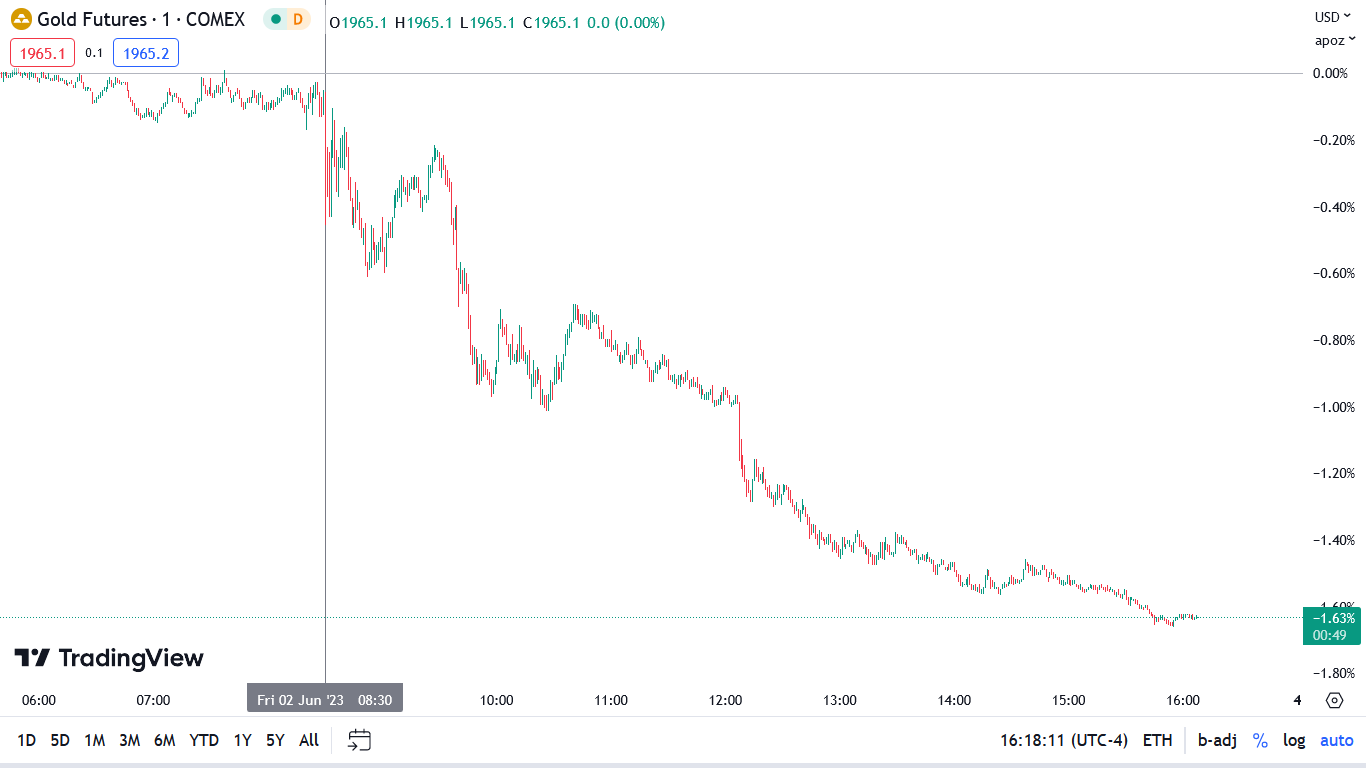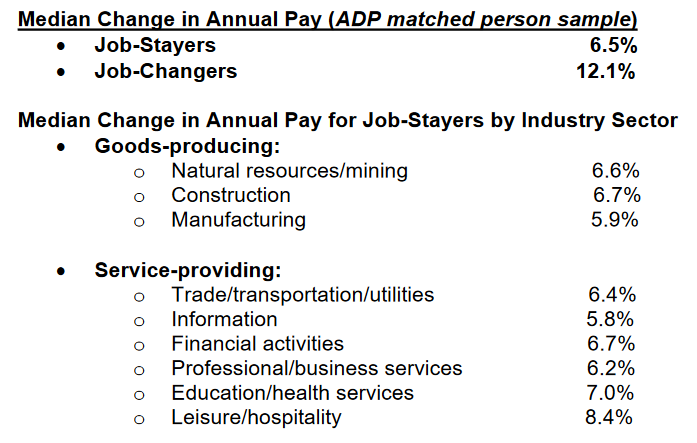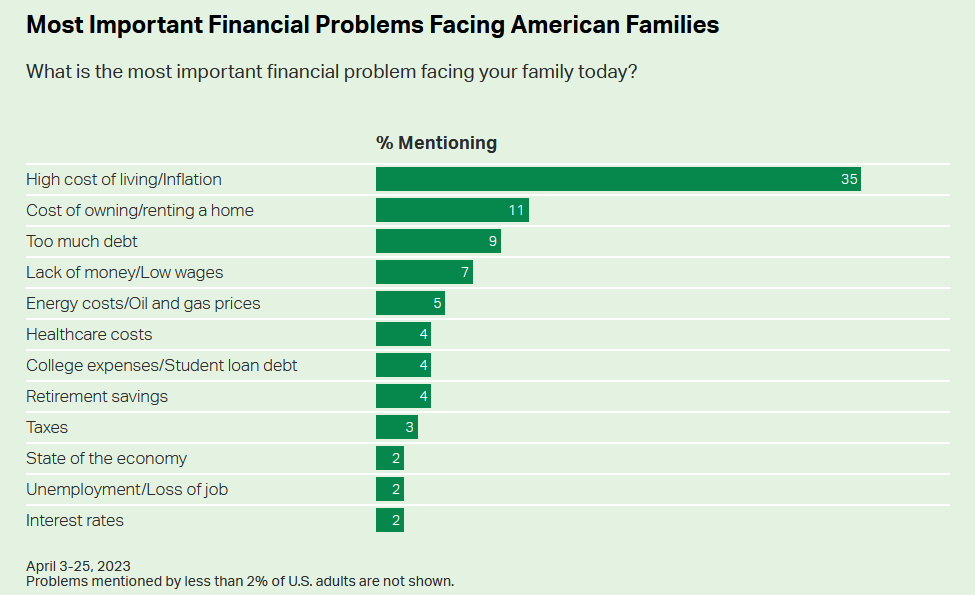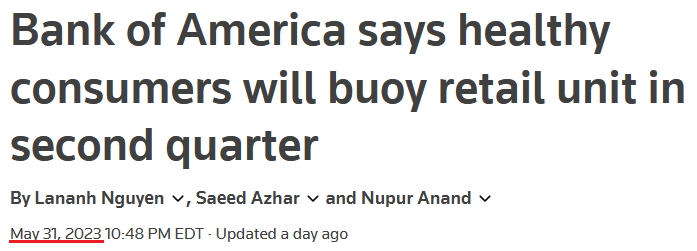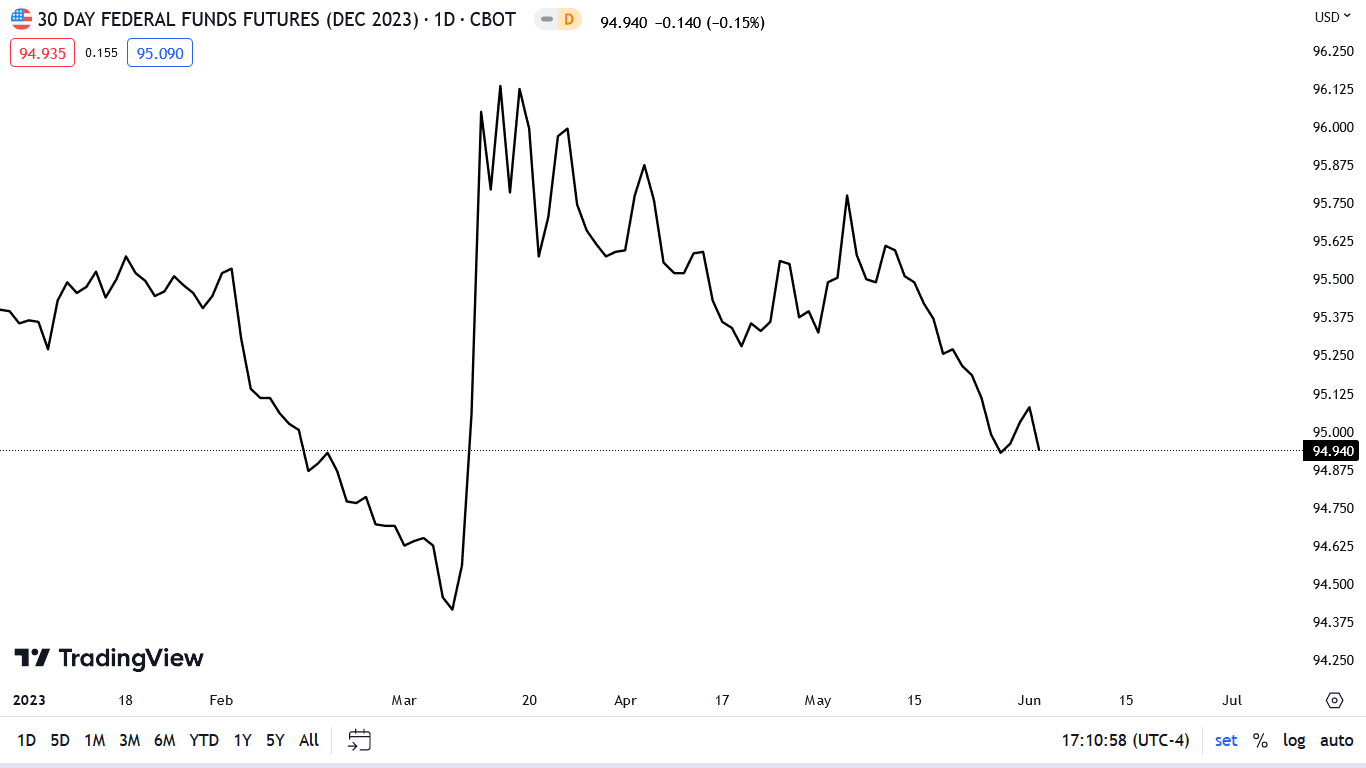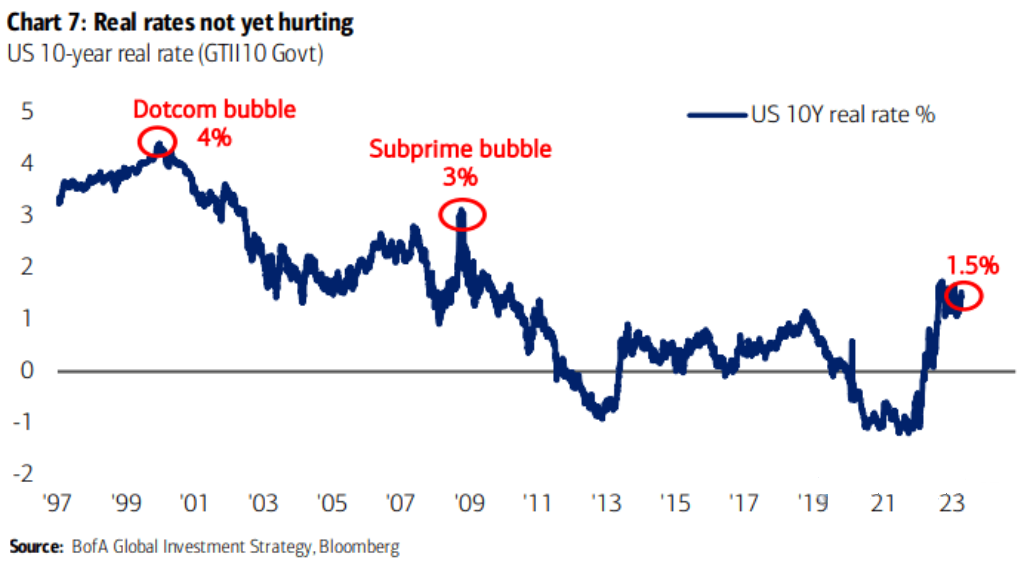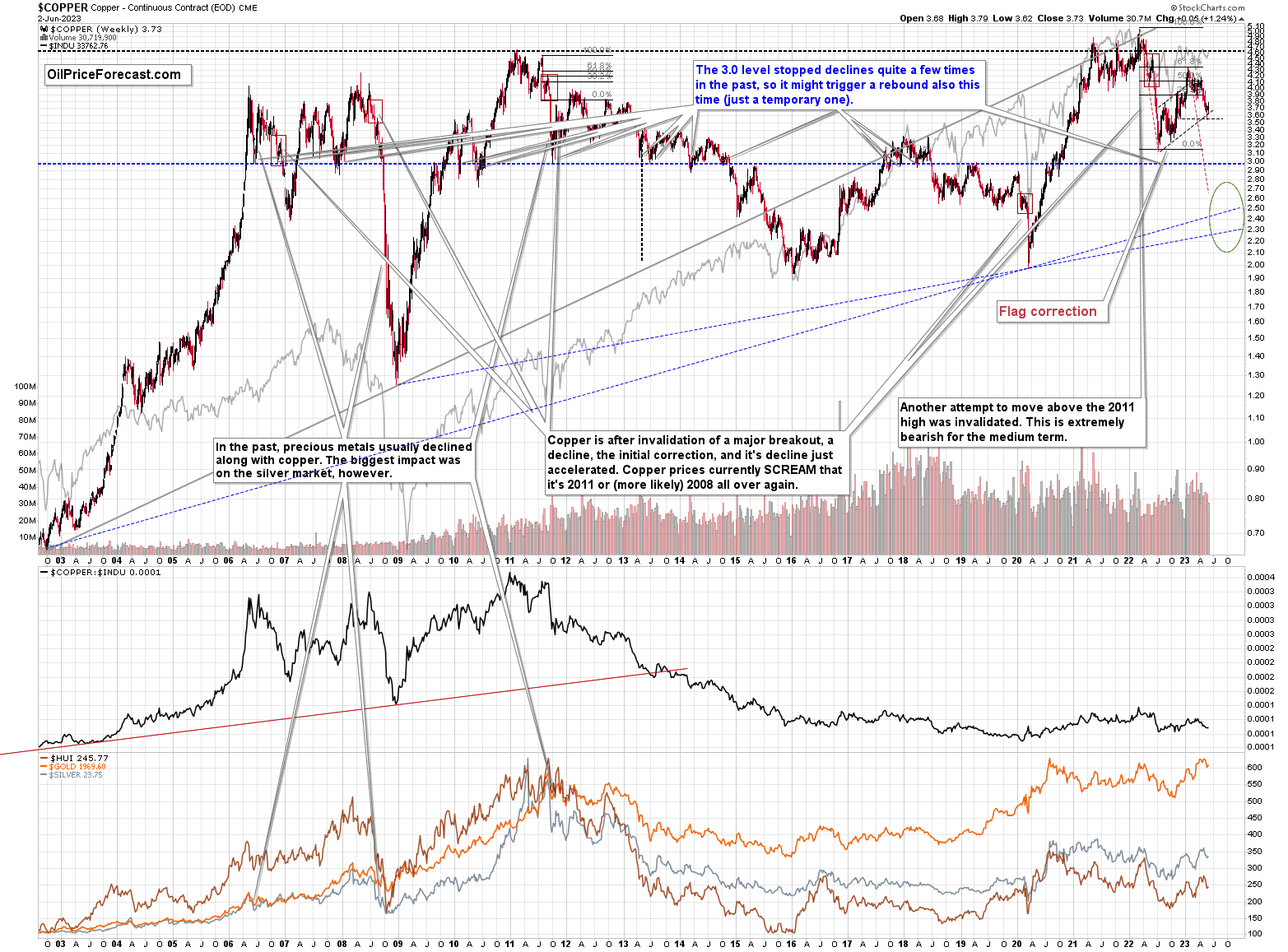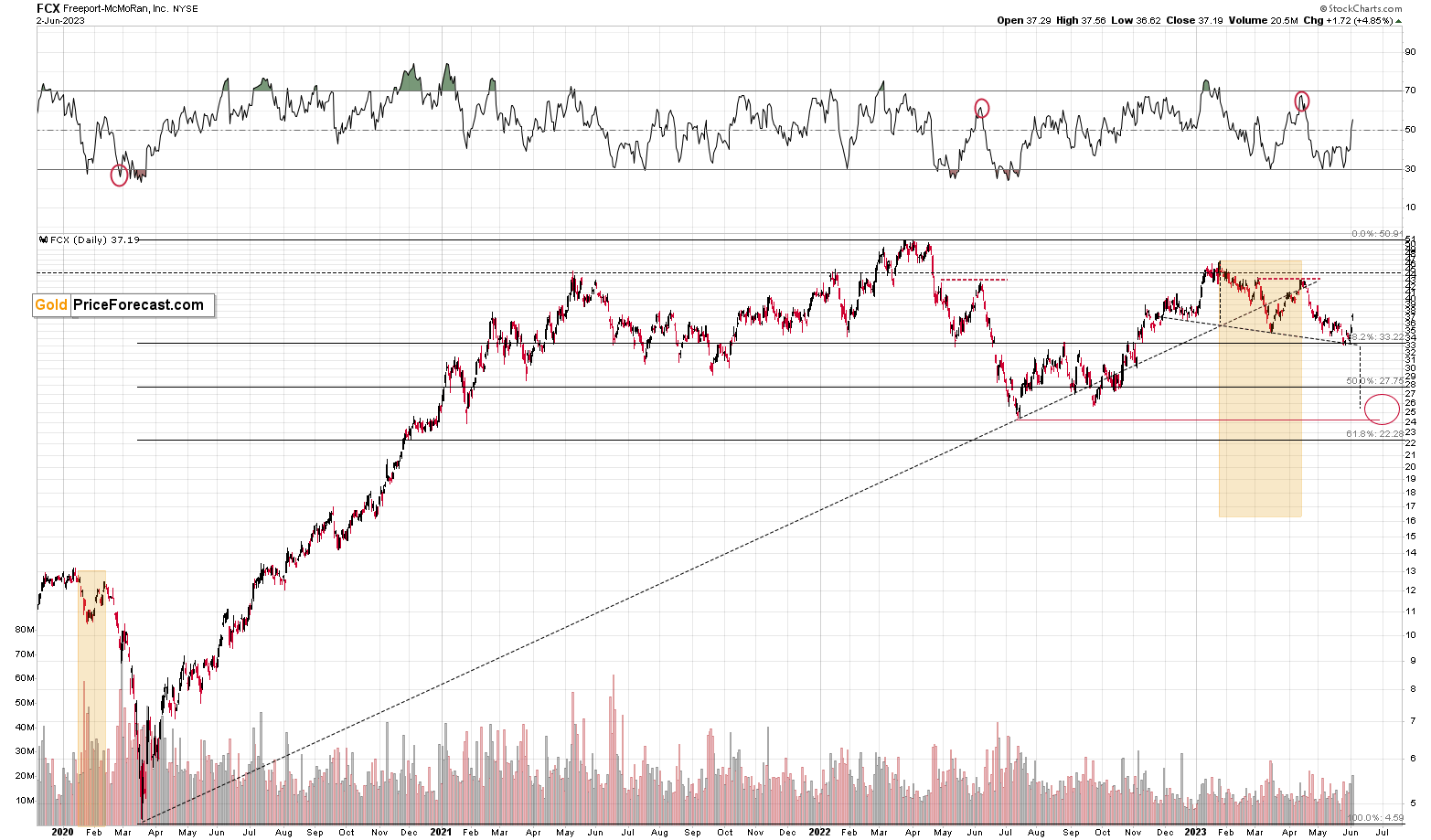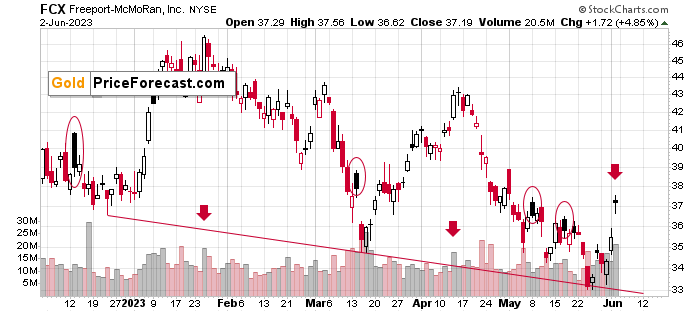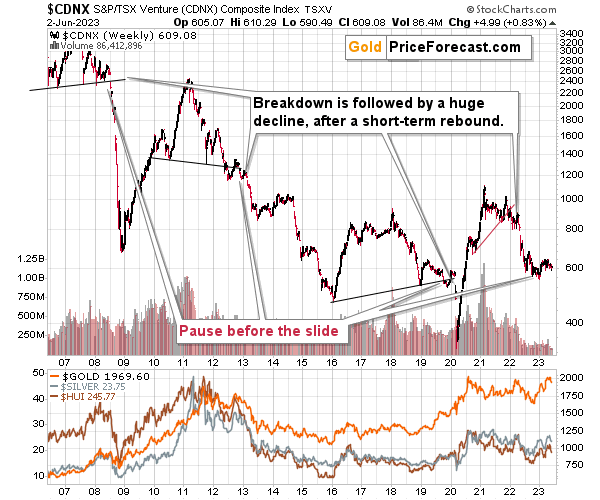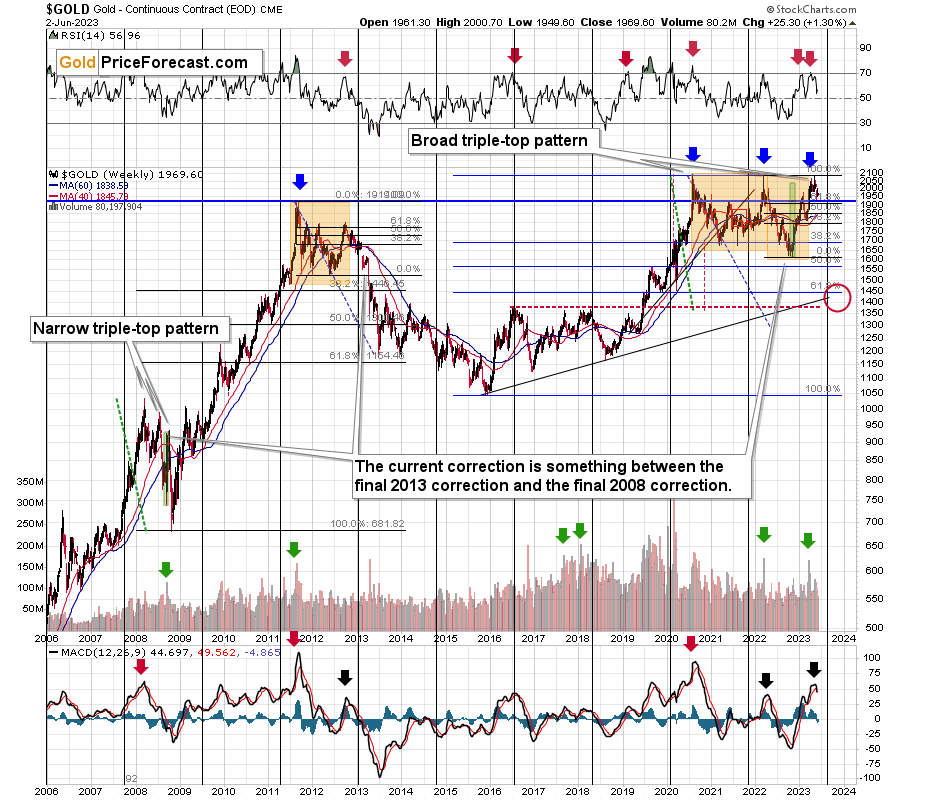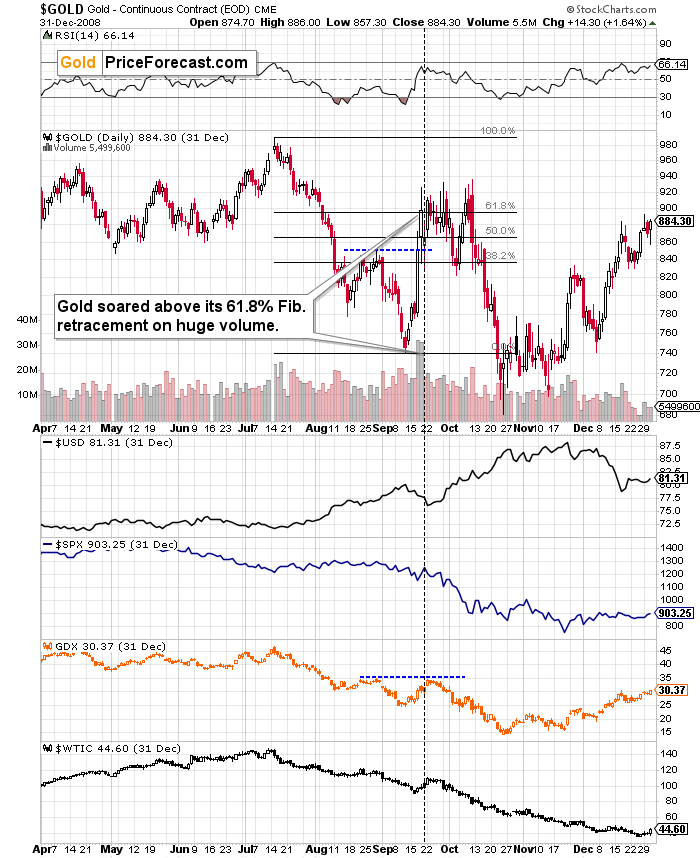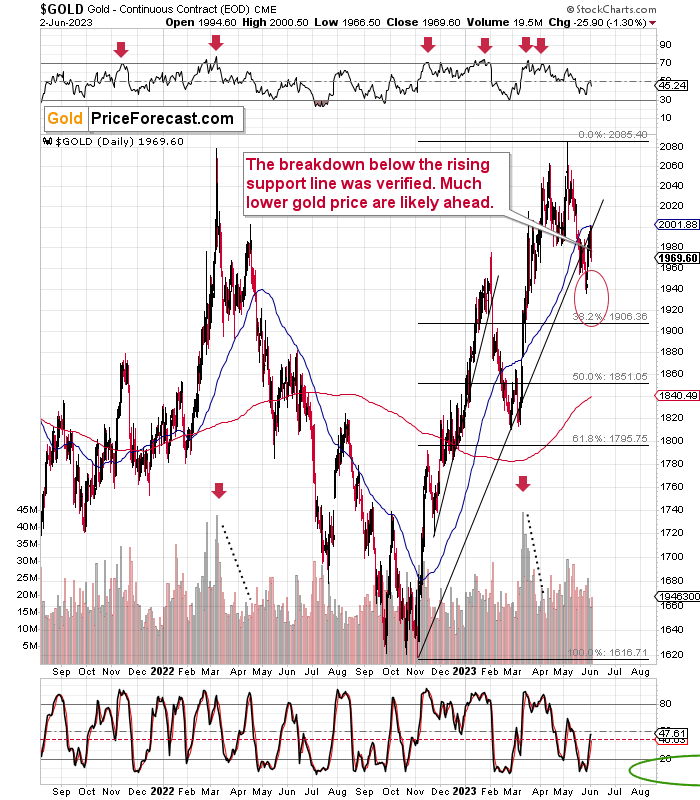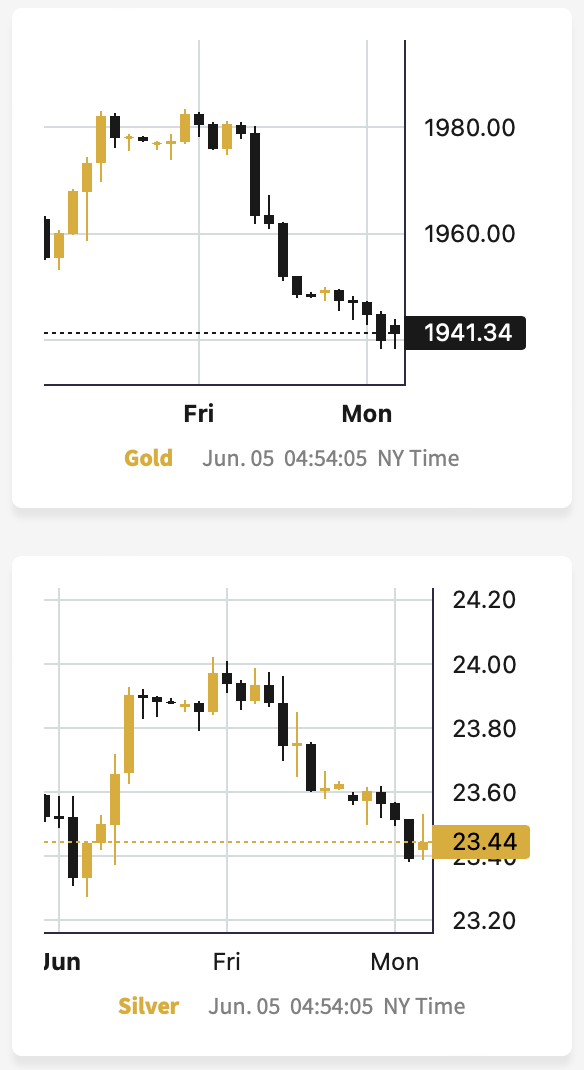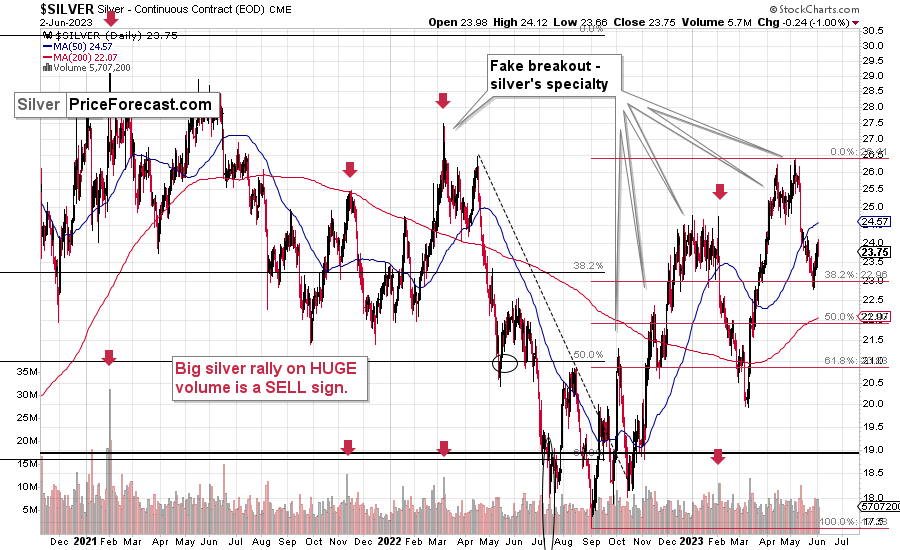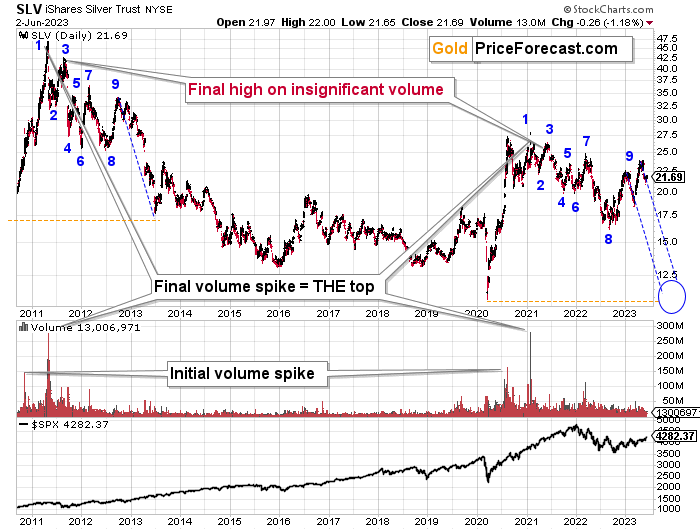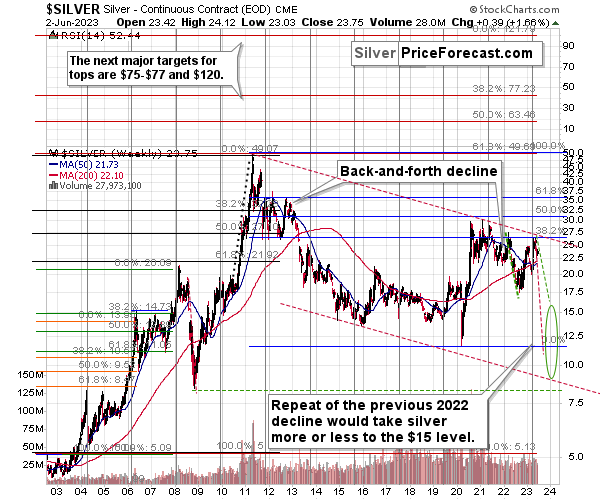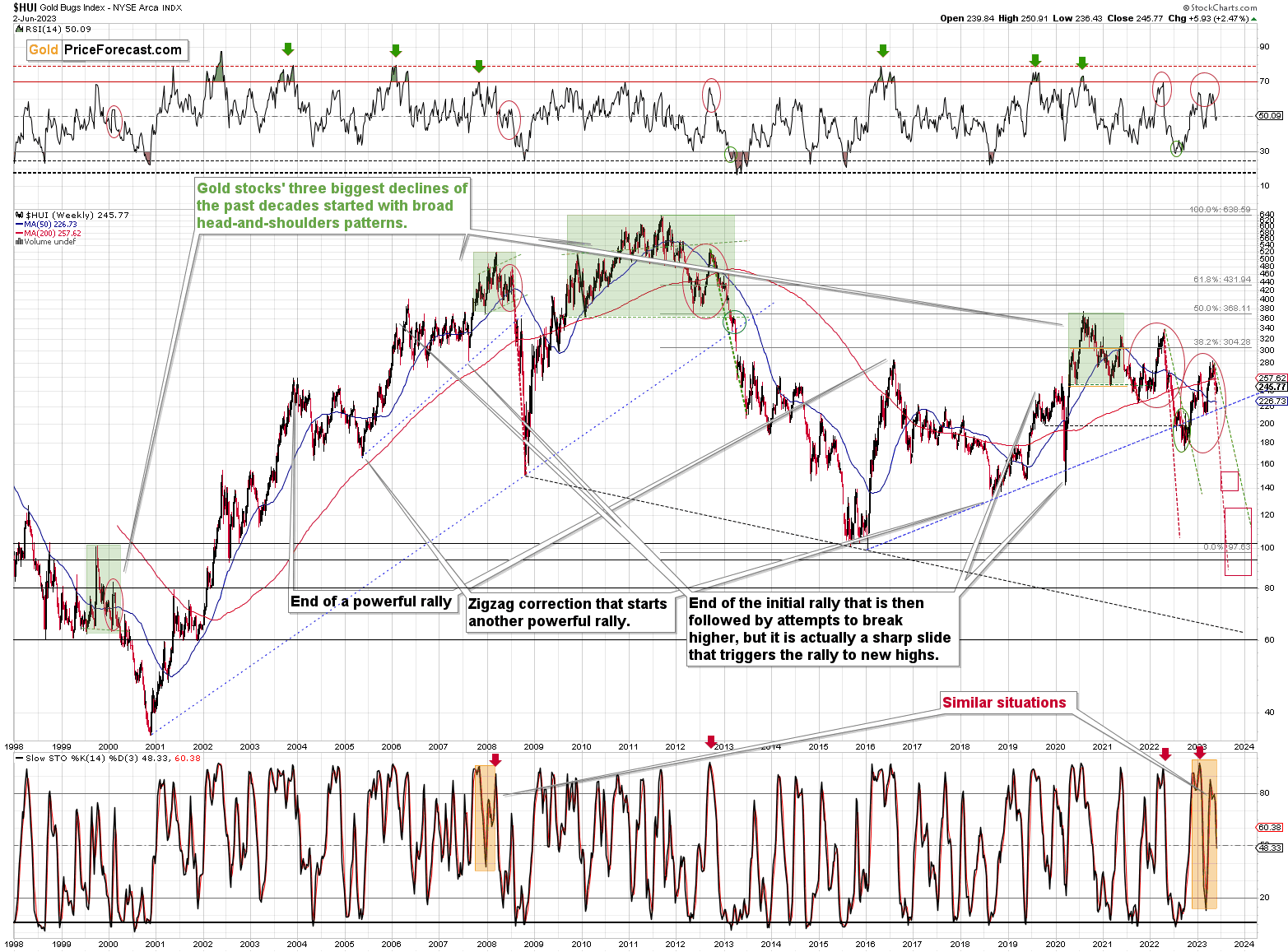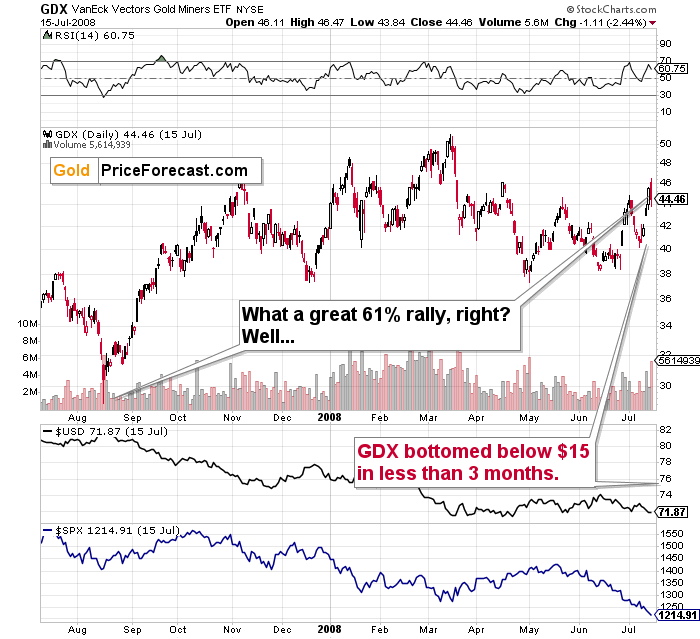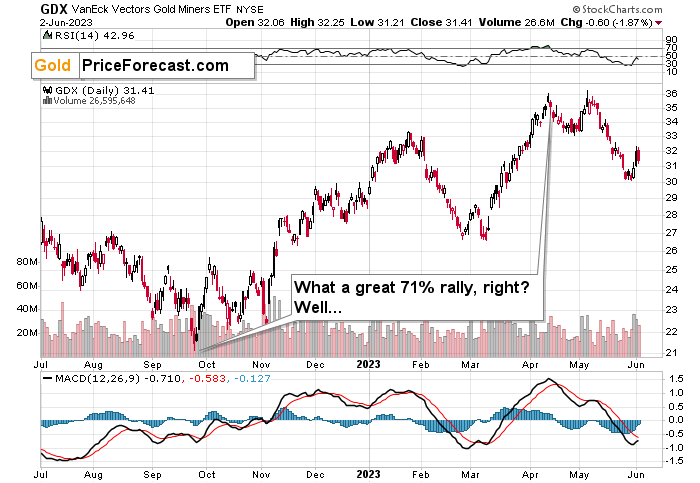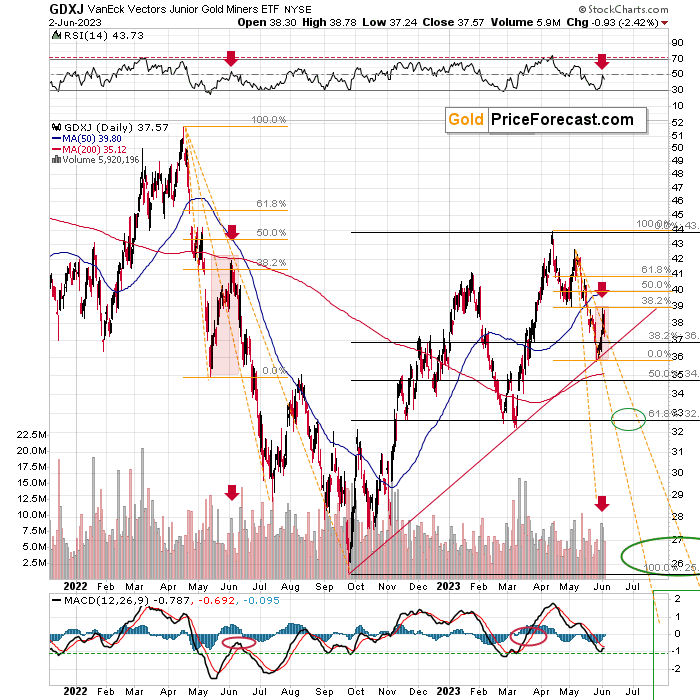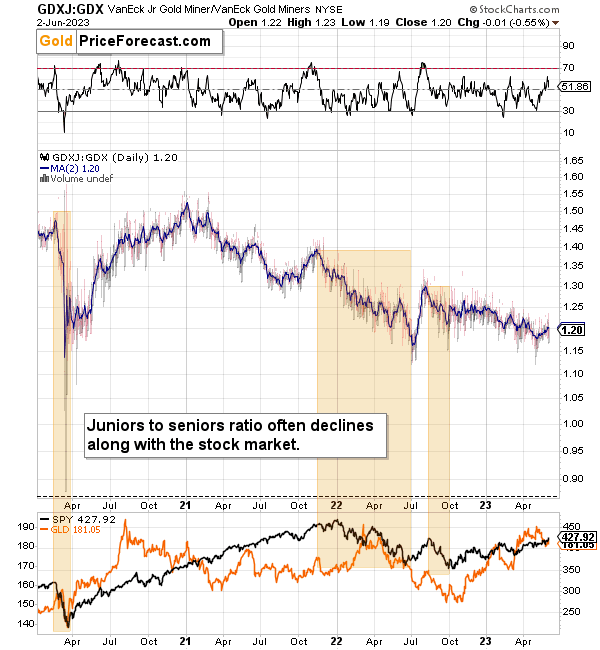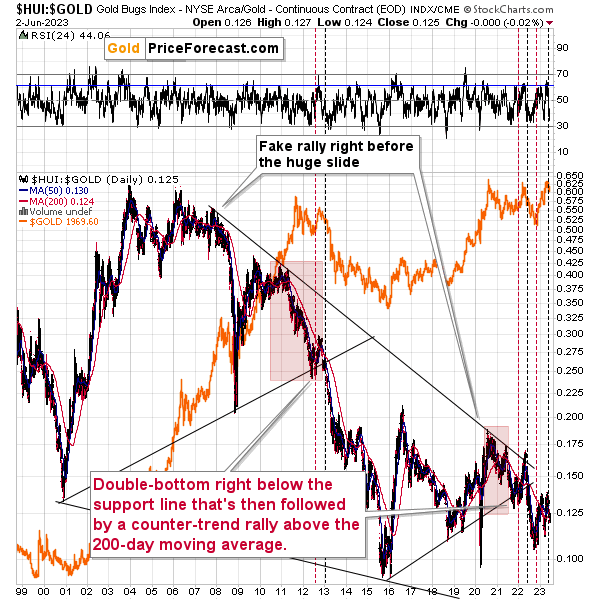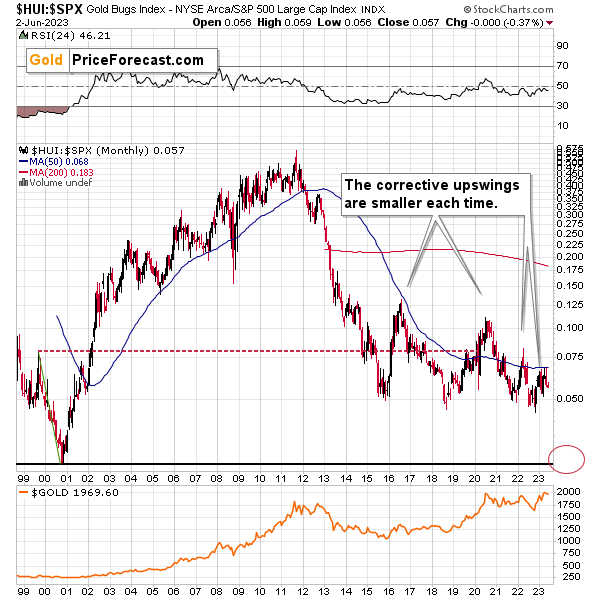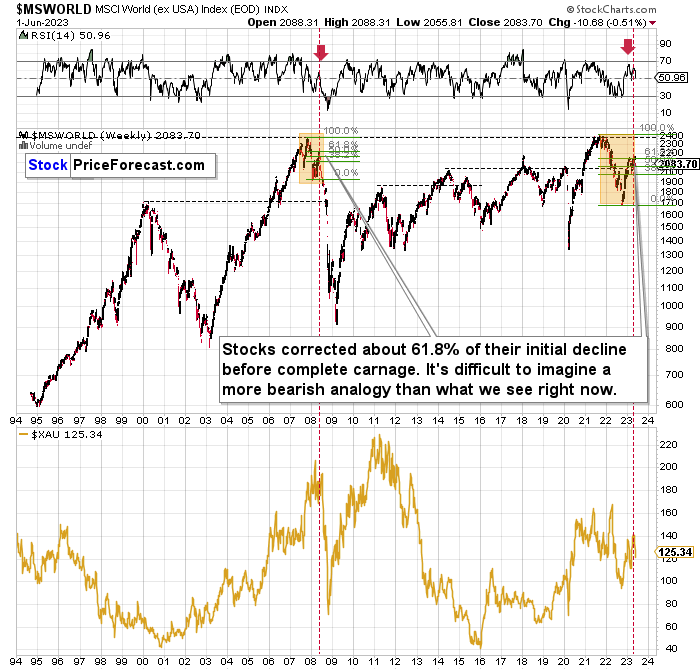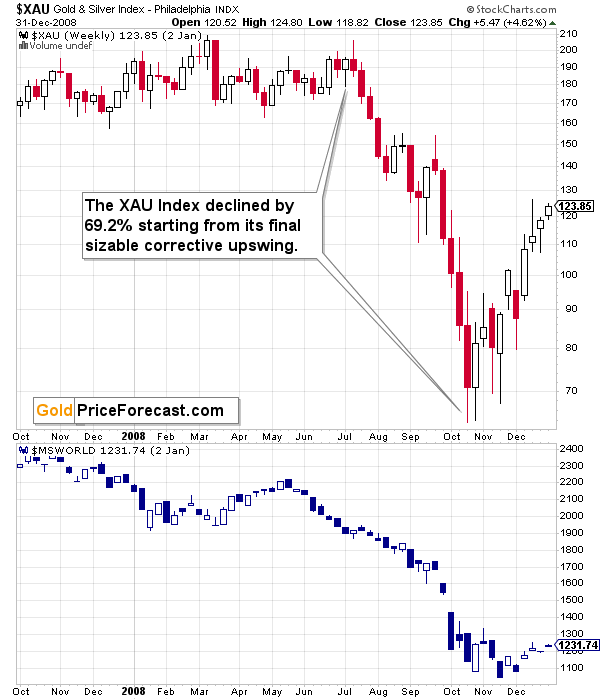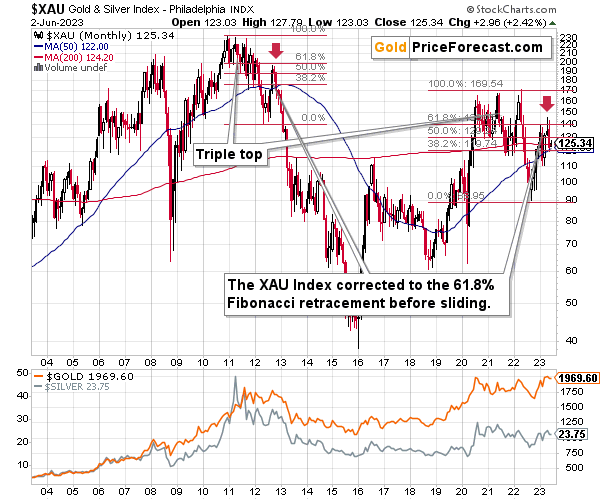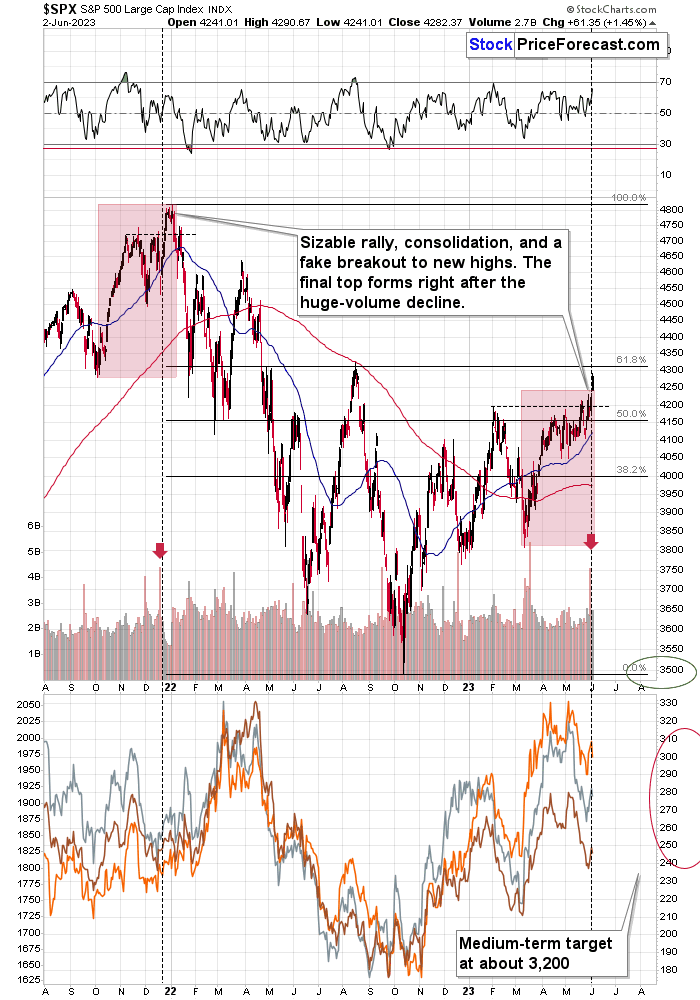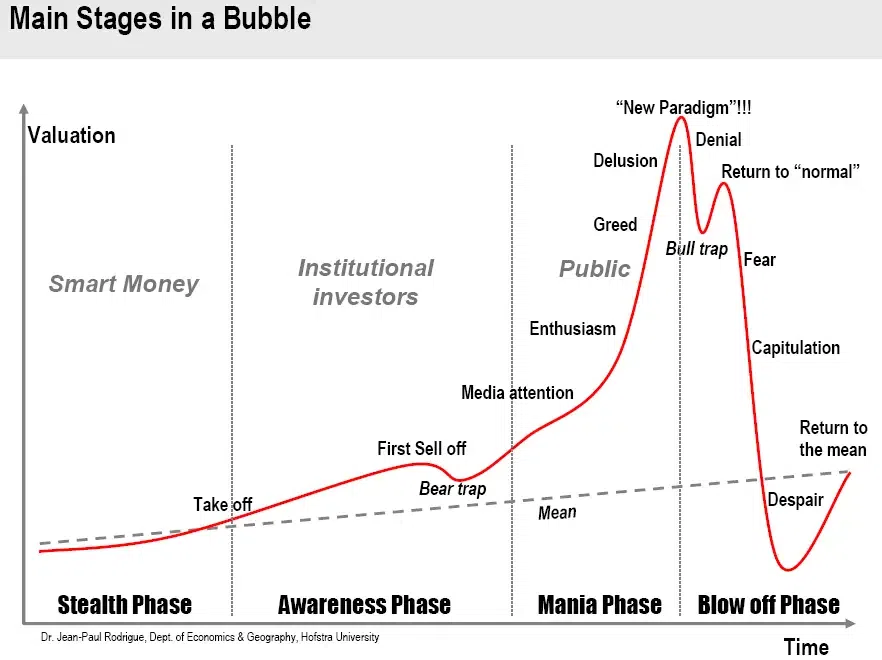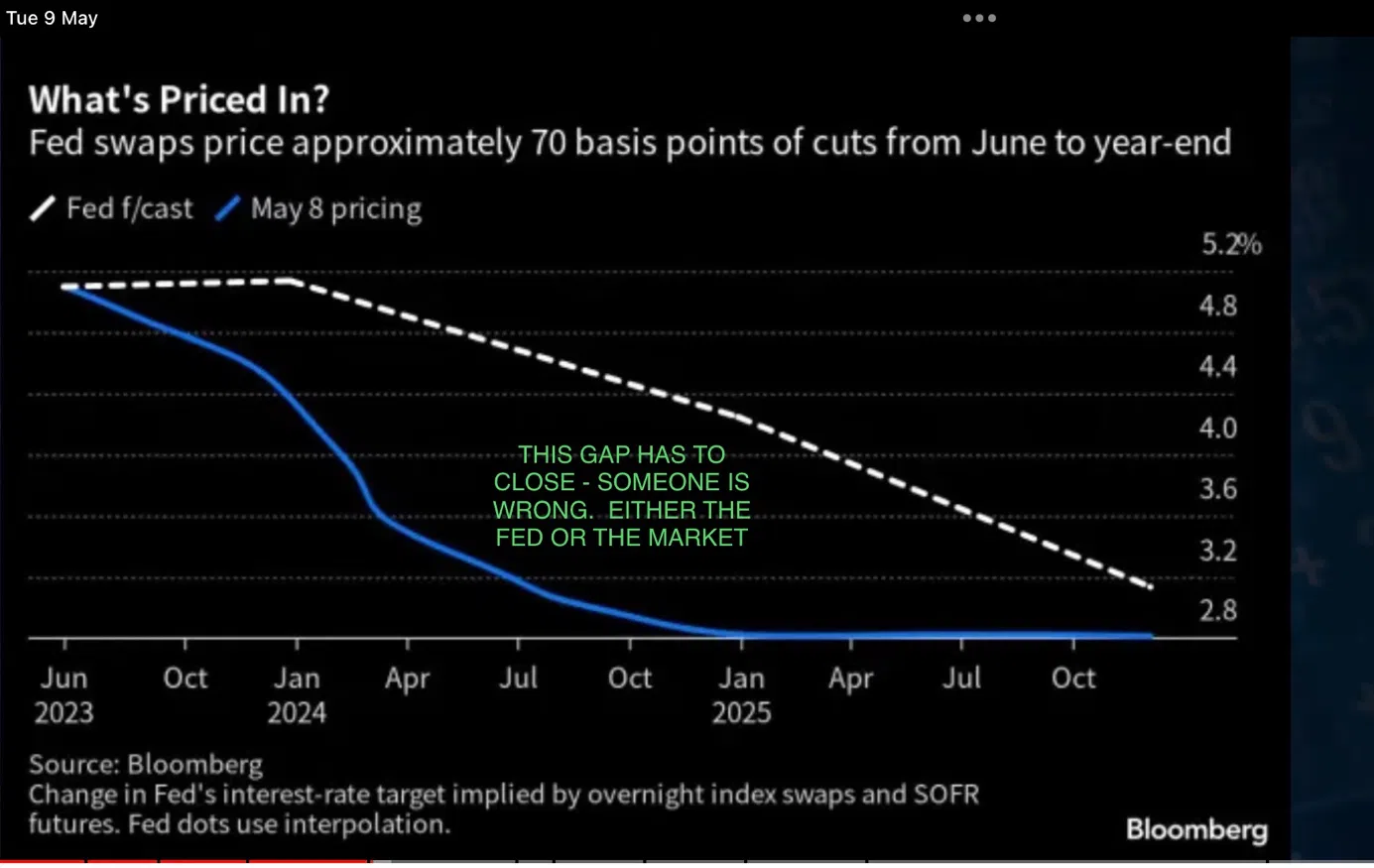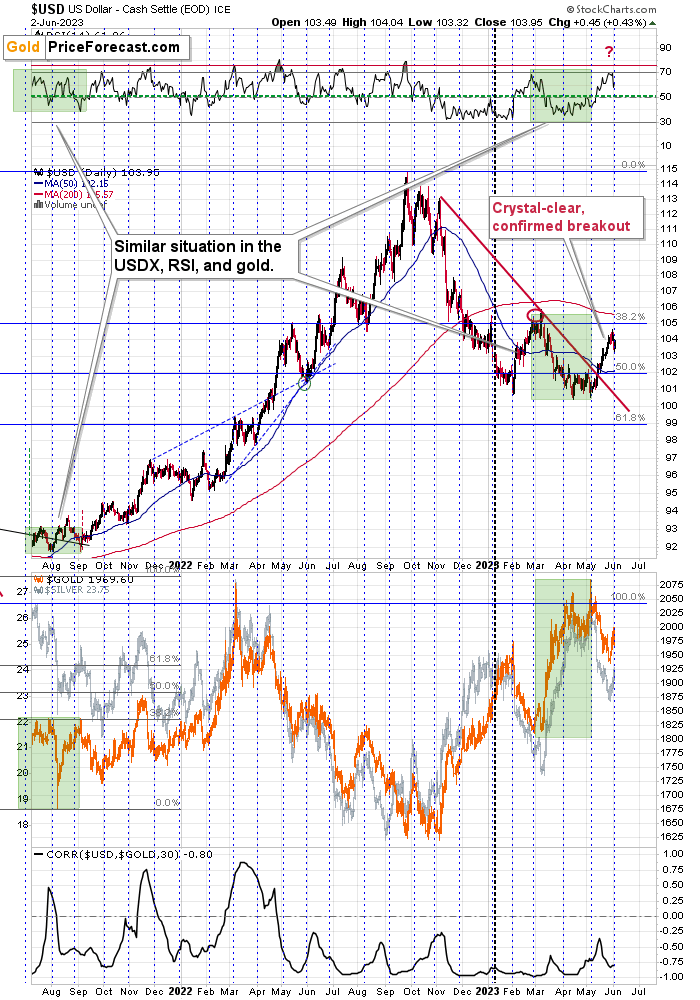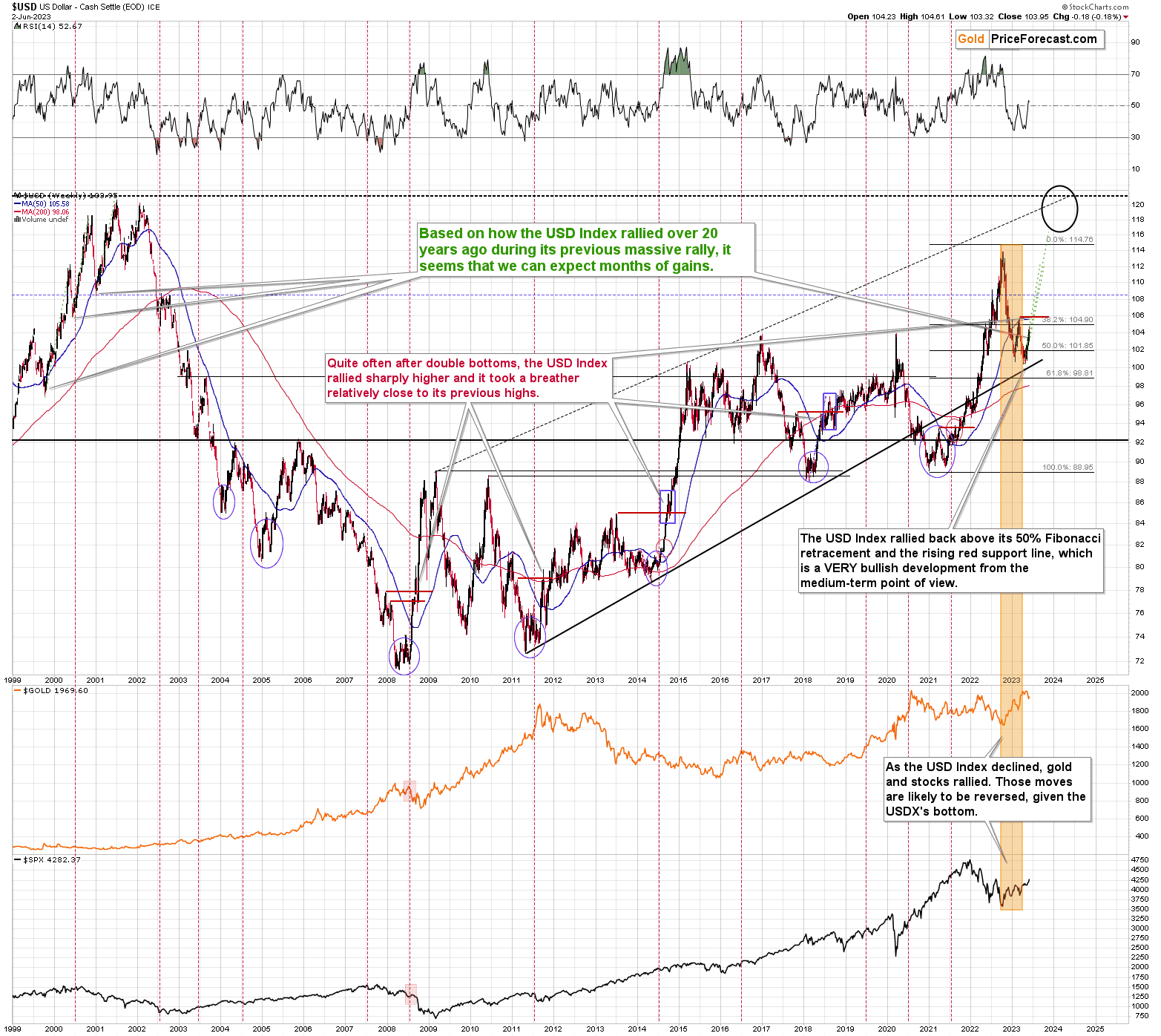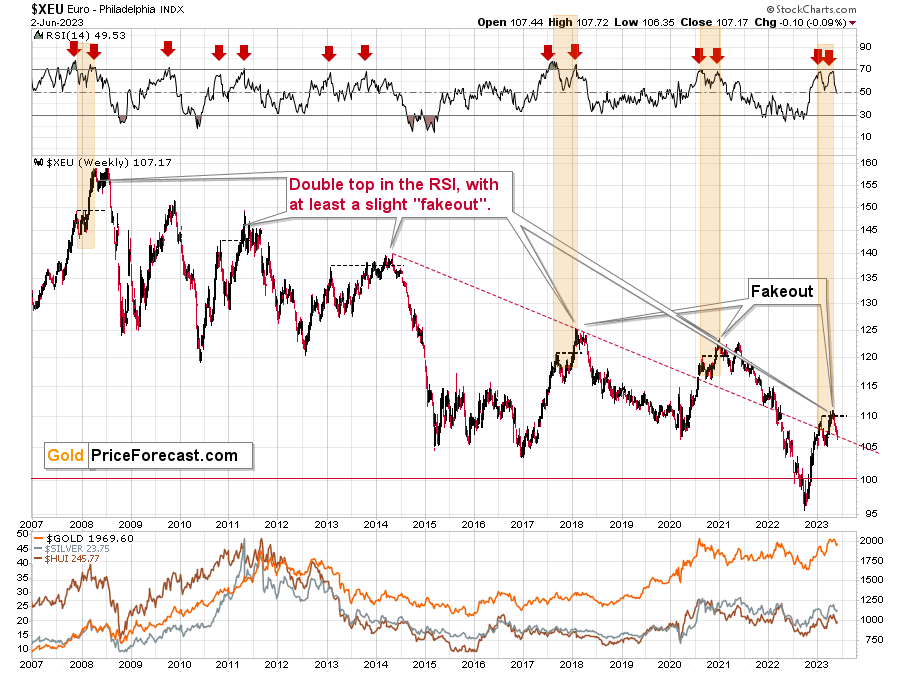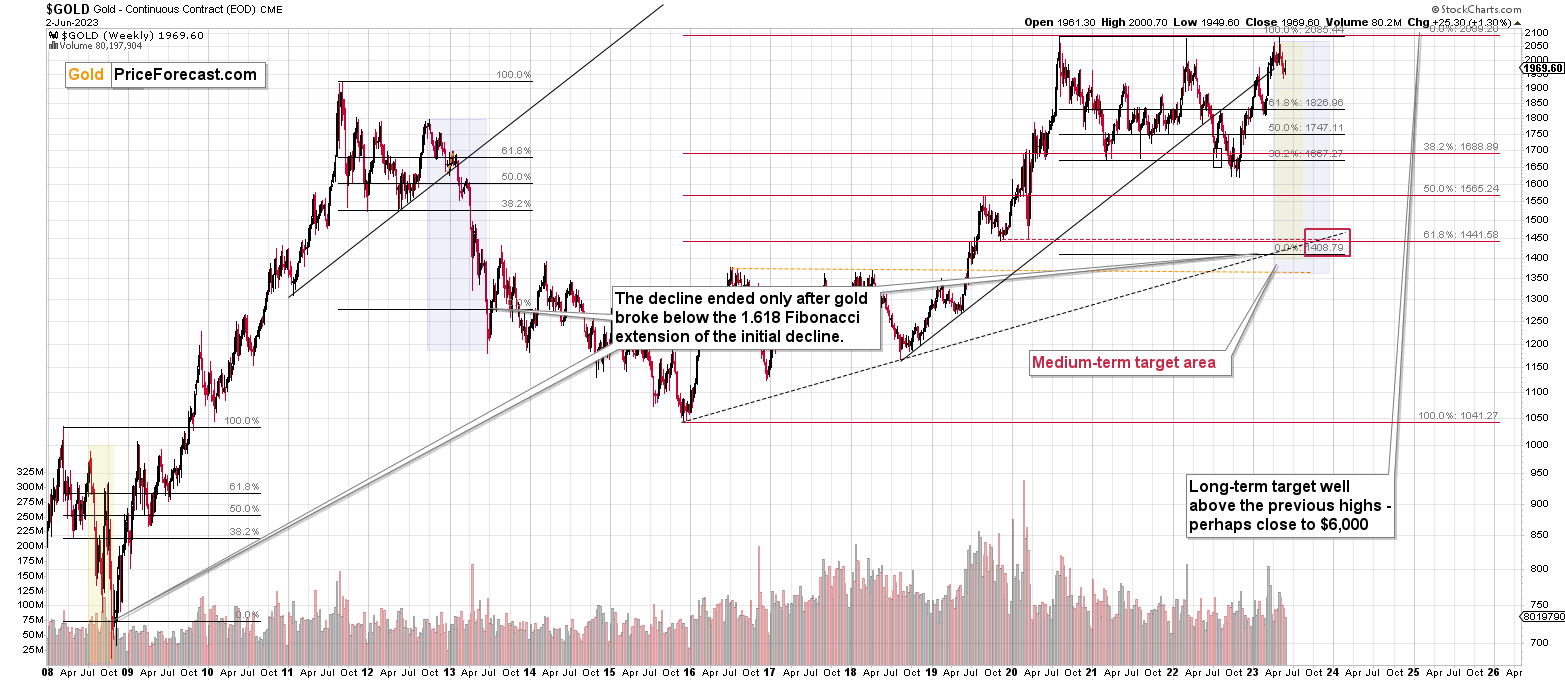Briefly: gold and the rest of the precious metals market are likely to decline in the next several weeks/months and then start another powerful rally. Gold’s strong bullish reversal/rally despite the USD Index’s continuous strength will likely be the signal confirming that the bottom is in.
Welcome to this week's Gold Investment Update.
Predicated on last week’s price moves, our most recently featured medium-term outlook remains the same as the price moves align with our expectations. On that account, there are parts of the previous analysis that didn’t change at all in the earlier days and are written in italics.
The key thing that’s most important from our point of view that happened this week is gold’s verification of the breakdown below its rising support line and the (likely final, for at least several months) “goodbye kiss” that the yellow metal gave to the $2,000 level.
Quite many things happened on the fundamental front as well, so I’ll take this opportunity to update you on those changes first, and I’ll move to the technicals next.
The Weekly Fundamental Roundup
With the debt ceiling drama ending with a whimper and resilient economic data uplifting Treasury yields and the USD Index, the PMs came down from their short-term sentiment highs. And with inflation poised to prove more problematic than the consensus appreciates, more of the same should unfold over the medium term.
Thus, while countertrend rallies are common along the way, we still believe gold, silver and mining stocks’ bear markets have more room to run.
Gold’s Fundamental Frailty
While the recession crowd amplified rate-cut hysteria and helped propel the yellow metal higher, we warned on Apr. 6 that the Fed’s tightening cycle was far from over. We wrote:
With relatively weak PMIs and a deceleration in JOLTS job openings garnering all of the attention this week, the recession crowd has bid bonds and the anxiety has helped uplift the PMs. Moreover, with fears of a banking crisis helping to increase their safe-haven appeal, gold, silver and mining stocks have outperformed.
Yet, we’ve seen this movie before and the permabulls are often the loudest near the top. Furthermore, since the fundamentals contrast the narrative – like they did during the countertrend rallies in 2021 and 2022 – another sharp reversal should be on the horizon.
To that point, with solid economic data shifting the narrative, the fundamentals continue to unfold as expected. For example, U.S. nonfarm payrolls came in at 339,000 versus 180,000 expected on Jun. 2, which highlights how labor demand remains abundant.
Please see below:
More importantly, the payrolls outperformance weighed on the gold price, as we’ve warned repeatedly that a resilient U.S. economy is bearish for the PMs.
Please see below:
To explain, the candlesticks above track the gold futures price. If you analyze the vertical gray line, you can see that after the payrolls print hit the wire at 8:30 a.m. ET, it was all downhill for the yellow metal. As such, while the medium-term technicals and fundamentals have been aligned for some time, the pair have begun to showcase their might.
The Inflation Puzzle
While U.S. average hourly earnings met expectations at 4.3% year-over-year (YoY), ADP’s private payrolls highlight sticky wage growth (data released on Jun. 1).
Please see below:
To explain, the median change in annual pay for job-stayers and job-switchers hit 6.5% and 12.1% in May. In addition, all of the industries tracked by ADP are experiencing wage inflation of ~6% or more.
Therefore, while base effects have reduced output inflation, those benefits run out after June. And while recession fears weighed on economically-sensitive commodities, which also helps reduce headline inflation, the S&P GSCI (commodity index) rallied materially in June. So, unless the Fed engineers a real recession, the inflation merry-go-round should continue.
Speaking of which, BlackRock CEO Larry Fink said on May 31 that “The Fed is not finished. Inflation is still too strong, too sticky.” And with the metric poised to stay in the 4% to 5% range “for some time,” he added, “I just don’t see the evidence around a reduction in inflation.”
Please see below:
On top of that, while the crowd assumes that inflation is old news, we have warned for many months that the fundamentals contrast investors’ optimism and the gold enthusiast’s medium-term bull thesis. And with Gallup’s May 18 poll supporting our argument, the Fed’s inflation problem can’t be wished away. The report stated:
“A separate Gallup poll, conducted by telephone April 3-25, finds inflation is by far the top trouble mentioned when Americans are asked to name the most important financial problem facing their family. The cost of owning or renting a home (11%) ranks a distant second to inflation, while having too much debt (9%) and a lack of money or low wages (7%) follow close behind.”
Please see below:
To explain, the vertical green bar at the top shows how 35% of Americans cited inflation as their most pressing problem. Thus, the prospect of the Fed cutting interest rates to exacerbate this problem was, and still is, foolish.
Likewise, the green bars at the bottom show how Americans remain unconcerned about job losses and interest rates. Therefore, it further confirms our belief that interest rates are too low to create the demand destruction necessary to eradicate inflation.
In reality, reducing inflation requires interest rates and job losses to rise to restrict consumption and economic growth. And if this were the case, more Americans would be worried about higher financing costs and prospective unemployment. So, the unfortunate truth is that for the top green bar to decrease, the bottom green bars need to increase.
Finally, Bank of America’s President of Retail Banking, Holly O'Neill reiterated our long-standing argument on May 31. She said:
“The consumer is still very healthy. Savings and account balances are still well above where they were pre-pandemic.”
As a result, data from the second-largest U.S. bank says that investors are still too optimistic about rate cuts and QE over the next several months.
Overall, the Fed’s tightening cycle is incomplete, which means that real interest rates and the USD Index should continue to rise over the medium term. And since gold, silver, and mining stocks often move opposite to these metrics, they should suffer as the drama unfolds. Consequently, we expect more downside before long-term buying opportunities emerge.
Why do U.S. nonfarm payrolls keep outperforming expectations?
Silver’s Swoon Should Resume
While the permabulls bought into the rate-cut hype, we warned on Apr. 14 that the fundamentals did not support their enthusiasm. We wrote:
Market participants are pricing in ~60 basis points of rate cuts. If those cuts get priced out, the market impact is similar to the Fed raising the U.S. federal funds rate (FFR). No matter how you slice it, no cuts means the FFR stays higher for longer, and a realization should have a profound impact on the PMs…..
Mining stocks are particularly vulnerable. The rate-cut optimism contrasts the realities on the ground, and market participants are overconfident because the Fed has been wrong more than it’s been right. However, we believe the QE bulls will suffer disappointment in the months ahead.
To that point, with investors erasing roughly two-thirds of the rate cuts priced in for December, the hawkish reset has unfolded as expected.
Please see below:
To explain, the black line above tracks the December Fed Funds Futures contract. And since the yield moves inversely to the price, the black line’s decent highlights how a bank run fears have abated, and economic reality is in style once again.
Moreover, the metric should have more room to run. With inflation too high and the unemployment rate too low, the Fed needs to maintain its hawkish stance to find the right equilibrium. And we believe rate cuts will continue to get priced out as these realities become more obvious.
Furthermore, while we have been consistent in our thesis that real interest rates need to rise to normalize inflation, Bank of America’s Chief Investment Strategist Michael Hartnett highlighted how the AI frenzy indicates inflation-adjusted yields are too low. He wrote:
“4% real yields popped internet bubble, 3% popped subprime, crypto crashed on real yield rip from -100bps to 150bps. But the market is telling you real rates may need to rise another 100-150 bps from here to pop ‘baby bubble’ in AI.”
Please see below:
To explain, the blue line’s movement on the right side of the chart shows how the U.S. 10-Year real yield soared by ~250 basis points in eight months. And unsurprisingly, the GDXJ ETF and silver suffered mightily along the way. Therefore, if resilient demand necessities another 100 to 150 basis point rise from here, silver could suffer a substantial drawdown.
As further evidence, the Fed released its latest Beige Book on May 31. An excerpt read:
“Economic activity was little changed overall in April and early May. Four Districts reported small increases in activity, six no change, and two slight to moderate declines….. Employment increased in most Districts, though at a slower pace than in previous reports. Overall, the labor market continued to be strong, with contacts reporting difficulty finding workers across a wide range of skill levels and industries.”
In addition:
“Prices rose moderately over the reporting period, though the rate of increase slowed in many Districts. Contacts in most Districts expected a similar pace of price increases in the coming months. Consumer prices continued to move up due to solid demand and rising costs, though several Districts noted greater price sensitivity by consumers than in the prior report.”
So, while the inflation data was somewhat mixed, the report highlighted how economic growth and employment remained resilient. Consequently, demand destruction has not unfolded with a 5.25% FFR.
Fed Whispers
Cleveland Fed President Loretta Mester said on May 31:
“I just think that we may have to go further. At this point, I don’t really necessarily see a compelling reason that we wouldn’t want to take another small step to counter some of that really embedded, stubborn inflationary pressure.”
Richmond Fed President Thomas Barkin said on May 30:
“However I look at it, it just looks like inflation is too high…. I believe you need to bring inflation down by bringing demand down.”
Yet, as we’ve stated repeatedly, he still sees resilient demand.
Please see below:
Similarly, while some Fed officials have advocated for a pause or not hiking at the June meeting, the overall hawkish message is clear. Remember, the crowd is still pricing in rate cuts. And if the Fed holds the FFR at 5.25% for the next seven months, it’s more hawkish than expected. Furthermore, we believe the FFR needs to rise further, and a realization should inflict plenty of pain on the PMs.
Again, we’ve noted on several occasions that the FFR has eclipsed the peak YoY core CPI in every tightening cycle since the 1950s. And with the latter peaking north of 6.6%, rate cuts are a fantasy, in our opinion.
Overall, the Taylor Rule implies an FFR in the 5% to 7% range. And unless long-term interest rates rise substantially or a Black Swan event unfolds, a 6%+ FFR should materialize before it’s all said and done. As such, silver is unlikely to board the QE train anytime soon.
Will the Fed cut the FFR at some point over the next seven months?
The Bottom Line
Reality is returning to the financial markets, as the crowd realizes resilient demand won’t die on its own. And with the shift supporting higher interest rates and a stronger USD Index, the developments are bearish for the PMs. In addition, while the stock market bulls confuse economic strength for a soft landing, history shows that periods of high inflation end with recessions. As a result, this cycle should be no different.
In conclusion, the PMs declined on Jun. 2, as payrolls outperformance was met with disdain. And more disappointment should confront gold, silver and mining stocks in the months ahead, as the USD Index and the U.S. 10-Year real yield surprise to the upside.
What to Watch for This Week
With more U.S. economic data releases next week, the most important are as follows:
- Jun. 5: ISM Services PMI, S&P Global Composite PMI
The heavyweight releases are nationwide surveys and should provide more insights into the growth, employment and inflation backdrops confronting the Fed.
All in all, economic data releases impact the PMs because they impact monetary policy. Moreover, if we continue to see higher employment and inflation, the Fed should keep its foot on the hawkish accelerator. If that occurs, the outcome is profoundly bearish for the PMs.
Technically Speaking
Let’s start today’s technical discussion with a quick check of copper prices.
Copper rallied recently, but it stopped at its 61.8% Fibonacci retracement level and then moved back down. Consequently, the recent move – while impressive from the day-to-day point of view – remains to be a short-term correction only.
Consequently, what I wrote about it previously remains up-to-date:
Copper recently CLEARLY invalidated another attempt to move above its 2011 high. This is a very strong technical sign that copper (one of the most popular commodities) is heading lower in the medium term.
No market moves up or down in a straight line (well, the 2008 slide appears to have been an exception), and a short-term correction doesn’t necessarily invalidate the bigger trend. For the last couple of months, copper has been trading sideways, but it didn’t change much regarding the outlook.
In fact, it made my previous target area even more likely. You see, the consolidation patterns are often followed by a move that’s similar to the move that preceded them. In this case, the previous 2022 decline was quite significant, and if it is repeated, one can expect copper to decline well below 3.
Actually, copper could decline profoundly and bottom in the $2.0-2.7 area. That’s where we have rising, long-term support lines and also the previous – 2016 and 2020 – lows.
Flag patterns (which we just saw in copper) tend to be followed by price moves that are similar to ones that preceded them. I marked this on the above chart with red, dashed lines. This method supports a copper price’s move to around $2.7.
Given the size of the previous decline (and its pace), it seems quite likely that it could take another 2-7 months for copper to move to about $2.4. May seems to be the most likely time target given the current data.
Interest rates are going up, just like they did before the 2008 slide. What did copper do before the 2008 slide? It failed to break above the previous (2006) high, and it was the failure of the second attempt to break higher that triggered the powerful decline. What happened then? Gold declined, but silver and mining stocks truly plunged.
Again, copper is after invalidation of a major breakout, a decline, and a correction. Copper prices currently SCREAM that it’s a variation of 2008 all over again. This is extremely bearish for mining stocks (especially juniors) and silver.
On a very short-term basis, though, please note that copper encountered two support levels and I marked both with black, dashed lines. One is a rising support line based on two previous bottoms, and the other one is the previous low. A bit over a week ago, I warned that this could trigger a corrective rally, and that’s exactly what happened. However, I also wrote that this is most likely going to be just a short-term phenomenon, after which copper’s downtrend is likely to be resumed. And this remains up-to-date.
Before moving further, I’d like to extend the copper analysis into the analysis of the situation in one of the major copper companies – FCX.
We just profitably closed a short position in it, but I’m featuring this chart to show you that the bearish potential that this asset has is still there.
The FCX moved higher last week, which is not surprising given the upswing in the S&P 500, and the small move higher in copper that I already wrote about above.
Still, it seems to me that this move is very temporary. Why? Because FCX was one of the very poor performers this year, and in the final part of a given upswing in stocks, the worst performers tend to rally.
The investment public simply buys whatever is cheap, without considering that some shares might be cheap for a reason. It was likely the same with the GDXJ, too.
We’ll move to the rally in stocks in the following part of the analysis. For now, let’s zoom in.
Also, since FCX’s performance is connected to one of the stock markets, you’ll see more bearish (medium-term) indications in the following part of the analysis, however, on a short-term basis, we saw a rally.
The special thing about this daily upswing is that it was accompanied by a huge volume. The last time we saw the volume this big, it was when the FCX was topping in April. Big daily volume is what also accompanied the January top.
So, we have another indication that Friday’s upswing was just a temporary blip on the radar screen and that the medium-term downside potential remains huge.
Having said that, let’s check the junior miners’ really big picture.
In short, we saw a tiny correction in the TSX Venture index, and this should be a major red flag for anyone thinking that the recent rally was a game- or trend-changer. This is a blip on the radar screen, similar to what we saw in the second half of 2021, before another big move lower.
The really important thing here is that we saw the first crack in the dam. The index declined visibly, and it might mean that the final part of the 2008-style slide has just begun.
Consequently, my previous comments on the above chart remain up-to-date:
The Toronto Stock Exchange Venture Index includes multiple junior mining stocks. It also includes other companies, but juniors are a large part of it, and they truly plunged in 2008.
In fact, they plunged in a major way after breaking below their medium-term support lines and after an initial corrective upswing. Guess what – this index is after a major medium-term breakdown and a short-term corrective upswing. It’s likely ready to fall – and to fall hard.
So, what’s likely to happen? We’re about to see a huge slide, even if we don’t see it within the next few days.
Just like it was the case in 2008, the move higher that we saw before the final (biggest) slide in gold, silver, and gold stocks (lower part of the chart), didn’t translate into a visible rally in the TSX Venture Index. Just as the index paused back then, it pauses right now.
Currently, it’s trading at about 600, and back then, it consolidated at about 2500. The price levels are different, but the overall shape of the price moves (lack thereof) is similar. This serves as a signal that the recent upswing in the PMs is not to be trusted.
The above chart is one of the weakest (from a technical point of view) that is seen across the board right now. There is a strong long-term downtrend visible in the TSX Venture Index, and if stocks slide similarly as they did in 2008, the TSXV could truly plunge – perhaps even to the 300 level or lower.
The important short-term detail is that the TSXV just broke to new yearly lows. This is a major (yet barely noticed by most) indication that the next big move lower is about to start.
Having said that, let’s turn to gold.
Let’s start with context:
Between 2020 and now, quite a lot happened, quite a lot of money was printed, and we saw a war breaking out in Europe. Yet gold failed to rally to new highs.
In fact, gold was just trading well below its 2011 high, which tells you a lot about the strength of this market. It’s almost absent.
There’s a war in Europe, and billions of dollars were printed, and gold was below its 2011 highs – in nominal terms! Adjusted for inflation, it’s much lower. And silver and gold stocks’ performance compared to their 2011 highs? Come on…
Truth be told, what we see in gold is quite in tune with what we saw after the 2011 top, and in particular, shortly after the 2012 top. We can also spot similarities between now and 2008. The long-term gold price chart below provides details.
Based on the most recent rally in gold, the price now seems quite similar to what we saw in 2008. This time, we see a triple-top pattern where the tops are far apart, whereas in 2008, they were relatively close to each other.
The link to 2011-2013 is still present, although in this case, the price moves to the upside are more visible.
To be more precise, I should say that those moves higher “were” visible, because – despite the intramonth run-up – gold was down in May; and it’s also down this month.
The RSI above 70 shows how extremely overbought gold just was and how likely it is to slide in the following weeks and months. I marked also other similar cases with red arrows, and as you can see, they were indeed followed by declines.
Please note that gold’s attempt to move to new all-time highs and the failure thereof are strongly pointing to lower prices ahead. The emotionality that I described in my recent Gold Trading Alerts had probably burnt itself out as gold approached the previous highs. And now, it’s time for logic and cold calculations to take its place. The reality is that real interest rates are going higher, and that’s very bearish for gold prices.
Finally, I marked the big increases in weekly volume levels during gold’s upswings with green arrows.
The most recent case is from 2022, when gold topped.
The same happened in early 2018.
That’s how gold topped in 2011.
And – most importantly – that’s exactly what we saw at the final pre-slide top in 2008.
Please note that the rapid rally that we saw in 2008 before the slide was very much in tune with what we saw recently (note: green rectangles). Consequently, it’s not a bullish game-changer.
Gold recently moved above $2,000, and just as all previous attempts to move above this level failed, we’re likely to see it fail once again.
Let’s take a look at how the situation developed on the technical front back in 2008.
Gold’s final pre-slide corrective upswing was based on turmoil, uncertainty, and safe-haven buying. It was volatile, it was large, and it was accompanied by huge volume.
The RSI indicator moved a bit below the 70 level.
Sounds familiar?
Back in September and October, 2008, gold even rallied above its 61.8% Fibonacci retracement level.
During that time, the USD Index declined in a relatively sharp manner, and the GDX ETF pretty much followed the stock market.
It’s exactly the same thing right now (except for the fact that gold moved even higher right now). Back then, stocks declined over time, and this time they are moving somewhat higher, but the mining-stocks link is just as it was in 2008.
Also, let’s keep in mind the situation in real interest rates. It might not be as sexy as bank collapses, but that remains one of the key reasons for gold’s decline in the following weeks/months.
Gold has a lot of catching up to do with its decline to “normalize” its link with real rates.
Another thing is that, given the major fundamental event that I already mentioned above (the war outbreak), it’s possible for the technical patterns to be prolonged and perhaps even repeated before the key consequence materialized. Similarly to the head-and-shoulders pattern that can have more than one right head before the breakdown and slide happen.
In gold’s case, this could mean that due to the post-invasion top, the entire 2011-2013-like pattern got two major highs instead of one. And thus, the initial decline and the subsequent correction are pretty much a repeat of what we saw in 2020 and early 2021, as well as what we saw in 2011 and 2012.
The current situation is truly special, as the rate hikes are something that we haven’t seen in a long time. The same goes for the level of concern about the inflation that’s “out there.” The latter implies that when faced with a decision about whether to fight inflation or help the economy, the Fed is likely to lean toward the former. And that’s bearish for assets like gold.
On a short-term basis, we see just how far gold declined recently, and how likely it is to decline once again shortly.
The key action that we saw in gold price last week was its comeback to the previously broken rising support line and verifying it as resistance.
That was it.
No major rally.
No comeback above $2,000 (despite the attempt).
Just a regular verification of an important, short-term breakdown. The above doesn’t provide a full picture because the decline continued after gold futures’ Friday’s closing bell.
As you can see on the below chart (courtesy of https://GoldPriceForecast.com), gold price moved even lower in this week’s early trading.
Silver joined gold in this decline, so it’s not something accidental.
So, a healthy breather appears to have already happened, and gold price’s decline can now resume. In fact, it seems that it already resumed.
Having said that, let’s take a closer look at the silver market.
I’ve been putting “fake breakout – silver’s specialty” annotation on the below chart for quite some time now, and this month’s performance shows you precisely why I’ve been doing it.
Silver faked its breakout once again!
And as Britney Spears might have sung, “oops, silver did it again!”
Invalidations of breakouts are strong sell signals, and given the importance of the 2023 high and how profound the invalidation was, the implications are very bearish.
A bit over a week ago, I wrote the following about the above chart:
The silver price currently moved to its 38.2% Fibonacci retracement level, which means that it might correct here, but… Again, the key word here is “might”. Given the analogy to 2008, white metal could decline much more before we see a meaningful correction.
We saw a correction, but it was not meaningful. Given what the gold price did on Friday and what it’s doing today, and given today’s pre-market decline in silver, it seems that the white metal’s correction is over as well.
Also, while it’s not visible on the above silver chart, the white metal is currently repeating its previous post-top performance. It’s crystal-clear on the below SLV ETF chart.
However, before we move on to the SLV ETF, let’s take a moment to recall the time when everyone and their brother were bullish on silver – in early 2021.
The silver price even tried to move above the $30 level, and it succeeded in doing so… For a brief moment.
Silver was “supposed to” take off. Shot up to the moon. Based on the physical market’s tightness, silver’s availability, a short squeeze, etc. Truth be told, it’s difficult not to write this with sarcasm (and I’m not), because I remember exactly the same reasons being used to justify silver forecasts above $100 back in the early 2000s. I’ve been there and I’ve been buying silver below $5, so I know a thing or three about what kind of analyses, discussions, and rumors were “out there” at those times.
Two decades later, the silver price rallied in a rather regular manner, along with gold, and then declined – also along with gold. To be precise – I’m not ruling out any of the above – short squeeze, shortages in general, etc. However, I am saying that just because something MIGHT EVENTUALLY happen, that doesn’t mean that it IS going to happen NOW or ANYTIME SOON.
For those exceptional situations, it’s great to have some physical silver (and gold, too). However, on a day-to-day basis, the investment and trading parts of one’s capital should be governed while putting great weight on things that are actually likely to happen in regular situations.
One way to thrive while trading silver is not to take silver’s strength at face value. Just as I warned that even if silver was about to soar (and I really DO expect silver to soar above $100 in the following years), then it was very unlikely to do so again in 2021 as the bigger trend was not supporting this outcome.
Anyway, when silver was trying to break above $30, I warned you about the real bearishness of the situation. (By the way, this link also proves that I’ve been expecting the interest rates to rise before that materialized.)
Many months later, we see that what formed in early 2021 was a major top that started a major medium-term decline.
Those of you who have been following my analyses for a long time might recall this chart.
I featured it originally many months ago, and the emphasis was on the analogy in price movement and in the spikes in SLV ETF’s volume.
Indeed – the situations proved to be analogous, and the silver price declined.
What’s remarkable is how similar the declines were.
What I added today are the counters (no, it’s not an Elliott Wave count), and I added the S&P 500 at the bottom of the chart.
The counters help to see which parts of the silver price movement are analogous. They are not identical, but they are much more similar than it seems that they “should be.” Even the “8” bottom was rather broad in both cases.
This time the “9” top is a bit different, but it sems that what we see now is analogous to what in late 2012 was the first counter-trend rally. Only this time, the top is above the initial top.
Based on this similarity, silver is now starting the main part of the slide. Its recent weakness relative to gold definitely confirms that.
Silver’s decline (and PMs decline in general) took a rather measured shape in its initial months (late 2012 – early 2013), so should we expect the same thing to happen now?
No.
The reason for this lies in the link to the stock market. Back in 2013, there was no visible decline in stocks, let alone a substantial one.
This time, we are likely to see one. And you know when we also saw some sharp declines in stocks? In 2008 and in 2020, and you can see the latter on the above chart. Silver plunged in a sharp (not measured!) manner in both cases.
Given rising interest rates and the investment public’s realization that the rates are not “about to move lower,” that is something that is likely to lead to the stock market’s sell-off. But I’ve been writing about that already.
The thing is that it has implications for the above-mentioned analogy in silver. And that is: the upcoming part of the decline in silver is likely to be sharper than what we saw in 2013. The same goes for the implications for mining stocks (and probably gold). This slide is likely already underway.
Let’s take a look at the situation from a broader point of view.
When looking at silver from a long-term point of view, it’s still obvious that the recent move higher was most likely just a corrective upswing.
What happens after corrections are over (as indicated by, i.e., silver’s fakeout)? The previous trend resumes. The previous trend was down, so that’s where silver is likely headed next.
Please note that silver just approached it 38.2% Fibonacci retracement based on its 2011-2020 decline and the declining long-term red resistance line based on the 2011 and 2021 highs. This resistance is likely to cause silver to move lower.
Let me emphasize silver’s long-term weakness here – gold just tried to move to all-time highs, and silver barely moved to the 38.2% retracement based on the decline from its high.
That’s not how major bull markets are born, especially that mining stock confirm silver’s weakness, not gold’s strength.
Moreover, it appears that silver’s long-term turning point marked the very recent medium-term top. Consequently, the price of silver and now decline in a profound manner. Please note that it was this kind of turning point that also accompanied the 2021 tops (approximately).
If silver declines by as much it declined in 2022, it will move to about $15, and I marked it with green, dashed lines.
However, if silver declines similarly to how it declined in 2008, it will reach its 2020 low and the slide will take a very sharp form.
We could also see something in between of those scenarios, but the overall implications are extremely bearish for the following weeks and months, anyway.
Due to its industrial uses, silver is known to move more than gold, in particular when the stock market is moving in the same way as gold does. Since I think that gold and stocks are both likely to slide, silver is indeed likely to decline in a truly profound manner. Quite likely lower than just $15.
Consequently, my prediction for silver prices remains bearish, as does the outlook for the rest of the precious metals sector.
Let’s not forget that rising interest rates are likely to negatively impact not just commodities, but practically all industries. This will likely cause silver’s price to decline profoundly, as silver’s industrial demand could be negatively impacted by lower economic growth (or a decline in economic activity).
Consequently, it seems that silver will need to decline profoundly before it rallies (to new all-time highs) once again.
Having said that, let’s take a look at what happened in mining stocks.
History tends to repeat itself. Not to the letter, but in general. The reason is that while economic circumstances change and technology advances, the decisions to buy and sell are still mostly based on two key emotions: fear and greed. They don’t change, and once similar things happen, people’s emotions emerge in similar ways, thus making specific historical events repeat themselves to a certain extent.
For example, right now, gold stocks are declining – and correcting – similarly to how they did in 2008 and in 2012-2013.
Moreover, the Stochastic indicator (lower part of the above chart) is currently performing just like it did at the 2008 top – so, the bearish similarity between those periods is not just in gold. In fact, given the rise above the 80 level, the situation is similar to both: 2008 and 2013 – to the top right before the final decline.
In mid-2008, the HUI Index – proxy for gold stocks – was moving higher. Quite visibly so. However, it’s important to note what accompanied this final pre-slide upswing in the HUI Index in case of the indicators.
The sentiment was just ridiculously positive, and it was just as positive back in 2008. Pretty much nobody was expecting what arrived next – the carnage.
This time, the volatility is even bigger (which is not that odd given that more money is floating around this time), but we can see that the indicator is behaving very similarly.
What I would like you to additionally focus on here is that the “double correction” theory that I described below gold’s long-term chart is clearly visible also here. We already saw the 2012 rally being repeated, and now we see it all over again. I marked them with red ellipses.
What are the implications? Well, obviously, they are bearish, as it was this correction in 2012 that started one of the most powerful declines of the previous decades. The RSI indicator based on the weekly prices is in a similar position to where it was at the late-2012 and 2022 tops. The consequences are clearly bearish for the following months.
My previous comments on the above chart, therefore, remain up-to-date:
The situation being what it is on the gold market (as discussed above) and the stock market (as I’ll discuss below), it seems to be only a matter of time before gold stocks slide.
For many months, I’ve been writing that the situation in the HUI Index is analogous to what we saw in 2008 and in 2013. Those declines were somewhat similar, yet different, and what we see now is indeed somewhere in between of those declines – in terms of the shape of the decline.
At first, the HUI Index declined just like it did in 2013, and the early 2022 rally appears to be similar to the late-2012 rally. However, the correction that we saw recently is also similar to the late-2012 rally.
Since history doesn’t repeat itself to the letter, but rhymes, is it really that odd that we now saw two corrective upswings instead of one? Not necessarily.
This is especially the case given that the 2008 decline had one sizable correction during the big decline. It’s not clearly visible on the above chart due to the pace of the 2008 slide, but it’s definitely there. You can see it more clearly in one of the below charts.
So, no, the recent rally is not an invalidation of the analogies to the previous patterns, it continues to rhyme with them in its own way. And the extremely bearish implications for the following months remain intact.
Also, I would like to take this opportunity to quote what I wrote recently regarding the sentiment that was present on the precious metals market right below the slide.
Today, I’m inviting you to join me on a journey to 2008.
You see, when we’re looking at the 2008 performance, or when we’re just thinking about it, we’re seeing the huge slide, and that’s pretty much all there is to it. Everything else gets tuned out as it’s not even comparably visible.
However, before the decline materialized, it was… well, not present at all. Nobody knew that it was just around the corner. Nobody “felt” the despair or the urgent need to sell mining stocks before they declined. And practically everyone felt this “need” after the prices were already low and it was time to buy (the irony…).
Today’s journey to 2008 is about looking at what everyone saw in July. Please imagine what everyone felt at that time.
The GDX ETF was after a several-month-long rally, and it just reversed, but it didn’t seem like a big deal at all. The short-term uptrend seemed strong.
The bulls were happy and confident at that time. The financial system had problems, as did the real estate market (nothing big, though - or so it seemed). Gold and gold stocks seemed like a solid bet – they are hedges against uncertainty, after all. Right?
The sentiment was very positive.
Math aligns with all the above: the GDX ETF was after a nice 60%+ run-up starting from its recent bottom.
The RSI was at about 70, but… Surely, miners were about to rally even more. Right?
Wrong.
Oh, so wrong.
What you see on the above chart was the final immediate-term high that preceded the unthinkable.
The GDX ETF plunged below $15, and it took less than 3 months for this decline to unwind. That’s about one-third of the most recent high, and about half of the low from which this “big 60%+” corrective rally started.
Fast-forward to the current situation.
The GDX ETF is after a nice, 71% run-up from its recent low.
The sentiment was very positive.
After all, gold and gold stocks are going to rally during uncertain times in the banking sector. Right?
It doesn’t matter that the RSI is above 70 and many other indications (even crude oil’s behavior) resemble what happened in 2008, right?
And it doesn’t matter that GDX just formed a daily shooting star reversal candlestick on huge volume, which is a classic sell signal, right?
So, it’s a great idea to be bullish at this moment. Right?
Wrong.
I know it “felt right” to be bullish at that time, but it was exactly the same thing before the slide started in 2008. This is what makes it so difficult to make money in the long run – to stay focused on what’s likely to happen and not follow the general sentiment.
GDX’s move back below its early-2023 high confirms the very bearish outlook.
How low can the HUI Index fall during the next big downswing?
As is the case with gold and silver, a move back to the 2020 lows is definitely in the cards. Please note that this level is also strengthened (as support) by other major lows: the 2019, 2014, and 2008 ones.
However, I wouldn’t rule out a move even lower on a temporary basis. If gold were to decline to about $1,450-1,500, it would mean that it would double its current 2022 decline. If the HUI Index does that, it will move below 150.
So, all in all, 80-120 is my current target area for the upcoming slide in the HUI Index.
What about the short run?
The RSI was just pointing to GDXJ being most overbought IN YEARS. Literally.
That was the top – probably the yearly top and the start of an enormous decline.
What happened last month clearly confirmed the above scenario.
A bit over a week ago, I wrote the following about the above chart:
Now, the GDXJ just touched its rising red support line that’s based on two important bottoms, and at the same time, the GDXJ-based RSI (based on daily prices) just moved slightly below 30. Both are good reasons to expect a near-term rebound in this ETF.
So, a rebound appears to be in the cards. However, whether this rebound is anything significant is a completely different matter.
You see, there were times when the GDXJ moved much higher based on the RSI at 30, and there were times when it moved back and forth and then plunged once again.
The thing is – out of the recent declines, the current move lower is most similar to what we saw a year ago, more-or-less at the same time of the year. In fact, even this most recent “seasonality” suggest that this analogy is most useful here.
If you look at late-April and early-May 2022, you’ll see that what happened was quite misleading for those that tried to take advantage of the supposed rally. The RSI was very close to 30 at the beginning, and GDXJ’s value was very close to its 200-day moving average (the red line) – just like what we see right now.
All that happened then was a relatively small upswing that was then followed by another huge wave down.
Since this is a quite likely outcome, the question is, if it’s worth to risk missing the decline in order to try to catch a dollar or two on the upside.
I might have considered this, if it wasn’t for the debt ceiling issue.
In my view, we’re likely headed toward the obvious – that it will be raised and that there won’t be any U.S. default. And then, as the tensions subside, we might see some sort of relief rally in stocks, but gold price could decline. After all, why own a safe-haven asset if the risk of the default was neutralized? Of course, there are many other reasons, but since this risk is lower, the willingness to purchase gold is also likely to be lower (and the willingness to sell it is likely to be higher).
As we move toward the above, all sorts of information could hit the market, so it might become “obvious” to the investors that “it’s all good” any day now.
In short, we have indeed seen the above taking place.
There was a corrective upswing, but not a significant one.
Of course, one might argue that the daily rally that we saw last week was significant on its own, and that true. However, given that it was immediately followed by a sizable daily downswing and gold is down in today’s pre-market trading, too, it means that it would have been very difficult for anyone taking advantage of this rally to get back into the short position or at least exit the long position profitably.
It seemed more realistically doable to just focus on the bigger picture rather than to try to time the intraday price swings.
The marvelous thing that happened due to last week’s sharp daily upswing is that the GDXJ corrected 38.2% of its recent decline, and at the same time the GDXJ-based RSI indicator moved to 50 (approximately). That’s exactly what the GDXJ needed at the same time, last year in order to truly slide in the following weeks.
And you know what? Gold miners didn’t even care that the general stock market moved so much higher on Friday, and they declined, nonetheless. It’s incredible just how weak mining stocks are at this time.
And yes, this creates a tremendous opportunity that many will notice only after it’s too late to take advantage of it.
Meanwhile, the relative performance of junior miners compared to senior miners continues to deteriorate in a medium-term trend.
You can see a tiny uptick in it in the very recent past.
However, you can also see that it’s part of a big downtrend, which the very recent uptick didn’t change at all.
This means that junior miners are still likely to decline more (probably much more, but I’ll move to that in just a second) in the not-too-distant future.
And here’s where things get really interesting for junior mining stocks because the additional thing that you can see on the above chart is that the declines in stocks particularly negatively impact the GDXJ to GDX ratio. In other words, when stocks fall, junior mining stocks fall more than senior mining stocks.
I marked all three bigger declines in stocks since 2020 with orange rectangles, and they were all accompanied by declines in the ratio. The 2020 decline was particularly brutal.
Please note that the line that you can see in the main part of the chart is a moving average based on two sessions, and I’m using it to make the ratio’s movement more visible. You can see the ratio itself in the background, and the truth is that it’s quite volatile at times. In 2020, for example, the ratio very briefly moved below 1!
Sometimes, the GDXJ to GDX ratio declined on its own, without the stock market’s help, but the important thing is that in each case, when we saw a major decline in stocks, the ratio declined in a significant way.
And since stocks are likely to slide profoundly in the following weeks/months, the implications for the ratio – and junior mining stocks are extremely bearish.
Also, let’s not forget about the forest while looking at individual trees. By that, I mean looking at how gold stocks perform relative to gold. That’s one of the major indications that the current situation is just like what we saw in 2012 top.
The situation in the gold stock to gold ratio is similar to what we saw in late 2012 and early 2013. The HUI-to-gold ratio invalidated its first attempt to break lower (marked with red, dashed lines), but after a corrective upswing, it then broke lower more decisively. That’s what I marked using black, dashed lines.
Recently, we saw a quick upswing in the ratio, but that’s not a game-changer – even the biggest declines had corrections in the past. In fact, the correction appears to be over, as the ratio declined sharply. This is yet another indication that the huge, medium-term downswing is already underway.
If history is to rhyme, we’re about to see a profound decline. In fact, we’re likely already past its beginning.
Also, please note that the pattern that we currently see, which started in early 2016, is somewhat similar to what happened between 2003 and 2008.
Back in 2008, the breakdown from the consolidation resulted in sharply lower ratio values and much lower prices for gold stocks.
So, if the situation is analogous to 2012-2013, we’re likely to see a big decline in the following weeks/months, and if it’s analogous to 2008, we’re likely to see an enormous decline in the following weeks/months.
Interestingly, the situation in the gold stocks to other stocks ratio (HUI Index vs. S&P 500 Index) provides the same implications but from a different angle.
The corrective upswings that we’ve been seeing since 2015 are getting smaller and smaller. The current one is visibly smaller than what we saw last year.
Consequently, it seems that the ratio is ripe for a breakdown below the 0.05 level. The next support is provided by the all-time low of 0.026. And yes, with the ratio at 0.065 right now, this implies a decline by about of 60%. If the HUI Index were to decline by 60% right now, it would have to move to about 100. If the stock market declined as well, it would imply the HUI was even lower.
Declining stock prices would only add fuel to the bearish fire (after all, gold stocks are… just stocks), and that’s exactly what’s likely to happen.
Just like what we saw in the case of copper and gold, world stocks corrected about 61.8% of their preceding decline. And that’s extremely bearish given the self-similarity to 2008.
Please note that the initial decline is now bigger than what we saw in 2008. Back then, stocks corrected about 61.8% of their initial decline before tumbling. And exactly the same thing happened recently!
Also, the RSI just turned south and back in 2008; that was the final confirmation before the waterfall selling.
Just as the 2008 rally wasn’t bullish, the most recent corrective upswing wasn’t bullish at all.
Real interest rates are rising, which is bad news for businesses! People appear to live on “hopium,” expecting the Fed to turn dovish and throw money on the market, but the data doesn’t support this outcome at all.
Given the analogy to 2008 and the fact that the initial slide was bigger this time, the following slide could be even bigger than what we saw in 2008. Naturally, this would be profoundly bearish for junior mining stocks.
This means that nothing really changed, and the situation remains extremely bearish based, i.e., on the analogy to what we saw after previous invalidations of long-term breakouts.
As a reminder, in early 2022, I wrote that the situation was very bearish as invalidations of previous breakouts were usually followed by massive declines – not just in stocks but also in precious metals.
When stocks invalidated their 2006 breakout in 2008, their prices truly crumbled.
We also saw that on a smaller scale in 2014, 2015, and early 2018.
We’re seeing it right now.
To clarify, we’re actually seeing the aftermath of the invalidation. The huge decline is already taking place.
The difference between now and 2008 is that back then the slide was more volatile, and we didn’t really see a visible correction during the plunge. This time, the decline is more measured, and we saw a correction to one of the most classic retracements imaginable – the 38.2% one. This correction doesn’t change the trend, which remains down.
Based on what happened in 2008, it seems that stocks are about to move much lower in the following months.
The lower part of the chart features the XAU Index, a proxy for both gold stocks and silver stocks.
First of all, this comparison of mining stocks and other stocks could appear shocking, and rightfully so.
The XAU Index is well below its… 1995 highs (yes, miners are really so weak), while world stocks are much higher.
The second shocker is how far and how fast miners declined in 2008. Starting with the final corrective upswing, the mining stocks index declined by a breathtaking 69.2%!
Less than a third of the starting value.
It took just a few months for this decline to materialize.
Based on this year’s performance, it’s clear that GDXJ’s price movement is slightly bigger and moves are more volatile (especially to the downside) than those in case of the XAU index.
As a result, the performance of both may be roughly comparable, or — more likely — junior miners may decline more due to their closer link to the general stock market. This means that based on the above-mentioned analogy to 2008, we can’t rule out a decline by about 70% (or more!) in the GDXJ starting at the recent short-term high ($43.89).
Shaving off 70% of that value leaves us with $13.17 as the possible downside target for the GDXJ ETF.
Impossible? It has already happened! (In the XAU, as the GDXJ wasn’t trading at that time yet).
So, yes, the outlook for mining stocks is truly extremely bearish for the following months.
Also, speaking of the XAU Index, let’s take a look at its chart.
After all, that’s where I see one of the key developments that happened this month.
How high did the XAU Index correct in a sharp manner back in 2021 before sliding from above 200 to below 40 (eventually, and below 90 in several months)?
It corrected to more or less its 61.8% Fibonacci retracement level. And the initial slide happened after a triple-top pattern.
Interestingly, we see exactly the same thing right now. Ok, the XAU moved slightly above this level, but it was quick to decline back below it.
The XAU Index first declined sharply after a triple-top pattern and now it just corrected approximately to its 61.8% Fibonacci retracement.
This is screaming long-term sell signal.
Also… Please note the obvious. The XAU Index is not only below its 2011 high. It’s not only below its 2008 high. It’s even below its 2006 high. Yes, the situation is as ridiculously bearish.
Let’s take a look at the markets from a more short-term point of view and from the U.S. perspective.
The debt-ceiling deal rally took stocks to new highs, and they are about to encounter a very strong resistance in the form of the mid-2022 high. This level is likely to hold due to the part of the cycle in which the market is most likely in (“return to normalcy”), and also due to the analogy to the previous situation when stocks first declined on huge volume and then rallied to new highs.
That happened in late-2021, and it was followed by the all-time high in the S&P 500.
Back then, the precious metals sector rallied, but that was due to the escalation of the situation in Ukraine, so that stocks-PMs link is not applicable right now.
On a side note, please note that the S&P 500 is more or less, where it was trading in April 2022 and so is gold. And yet, miners are well below their April 2022 levels. Did I already emphasize miners’ weakness enough times already?
Given the similarity between now and what happened right before the all-time high and the likelihood that the link between stocks and the precious metals sector (in particular junior mining stocks) is currently intact (they move mostly together), the implications of all the above are very bearish for the following weeks and months.
As I wrote above, it seems that investors are right now in the “return to normalcy” stage from the short-term and long-term points of view given the above and the above-discussed situation in world stocks.
And this market juncture makes it very difficult to stay calm and objective (which would explain the small rally and the previous tiny breakout to new highs in the S&P 500).
The “return to normalcy” stage is when the vast majority of market participants expect the previously unsustainable rally to be continued, even though much has changed and it’s already a different stage of the market. It’s no longer a bull market.
I’m writing about the stock market here, but the emotionality spreads to other markets as well. That’s most likely why people are not reacting to the massive increases in real interest rates as much as they “should”.
The current expectations regarding the Fed’s interest rate decisions also fall in line. Here’s a chart that Simon just shared in the comment feed below one of the recent Gold Trading Alerts:
Market’s expectations are MUCH more dovish and bullish for stocks, than Fed’s. “Don’t fight the Fed” doesn’t apply now?
And that’s Fed’s forecast, which assumes that inflation will come back down. If it does – real interest rates move higher. If it doesn’t, the Fed will need to keep raising rates. Which means that real interest rates are likely to move higher anyway. Either way, the implications for the precious metals market – and for stocks – are bearish for the following months.
Also, while I’m writing about the Fed. Please note that Jerome Powell is anything but direct. In my opinion, he really wants to avoid the blame for the carnage that's likely to hit the general stock market. When the plunge happens, he doesn't want to be the one that triggers it, but rather someone that tries to prevent it.
The disillusionment will be painful for many.
Consequently, I think that the breakout will be invalidated soon. And it could be the tipping point leading to a sharp decline.
Why is this important for gold and silver investors and traders? Because the last two big moves took place more or less in line with each other – in stocks and in precious metals (and miners). The slide in stocks could also trigger something similar in the case of commodities like crude oil. The same thing is likely to happen again this time, especially given what’s happening in the USD Index.
On May 15, I described the above chart in the following way:
The big thing that happened last week is that the USD Index finally showed strength in a really meaningful manner.
Thanks to last week’s rally, the USD Index finally broke above the declining red resistance line based on the previous important highs.
This is a game-changer for the following weeks. On a day-to-day basis, a move lower to this red line would be normal, as breakouts can be verified in this way, and that’s nothing to write home about. In fact, the USD Index moved a bit lower in today’s pre-market movement, and yes, it’s perfectly normal. It doesn’t invalidate the massively bullish implications of the breakout.
The rally was really notable, and it’s visible at first sight while looking at the above daily chart. But the really big difference becomes visible when we consider what happened on a week-to-week basis.
As surprising as it may seem, the last weekly close was the highest weekly close since late March!
Indeed, the USD Index rallied since that time. The key point here is that this is most likely just the beginning. Yes, there will be some corrections along the way (in fact, we just saw one), but the odds are that the next big move is to the upside – and that it has already started.
The USDX has a tendency to reverse close to the turn of each month, and it seems that this corrective downswing is already in the past. It also helped to bring the RSI well below 70, clearing the way toward further gains.
Most important details are present on the long-term chart, though.
Let’s zoom out.
The USD Index is that after major double bottom, and when it was in this position – and after a short-term rally, the USD Index usually took a breather relatively close to its previous highs.
I marked that on the above chart with small red horizontal lines. The most recent short-term high is provided by the early high – at about 105-106. Interestingly, that’s also where we see the 200-day moving average.
This means that the USD Index could indeed rally more in the near term, and this means that the precious metals sector might move even lower before it corrects in a more meaningful manner.
On the other hand, we just saw a tiny breather, and it might be enough for the USDX to continue its rally without a bigger correction for several weeks.
The key thing to keep in mind is that what we see right now – along with the most recent very short-term decline – is something that we also saw in mid-2008, right before the USD Index’s sharpest rally in decades. Interestingly, we also saw it in 2011 right before gold’s top.
The preceding bottom was not a single V-shaped low, but rather a bottom that consisted of a few separate bottoms. The final short-term decline started with RSI at about 50. And guess what – the current short-term decline also started with the RSI close to 50.
Consequently, given all the other links to 2008, it seems that a big rally in the USD Index is just around the corner.
The situation in the biggest component of the USD Index: the EUR/USD exchange rate confirms the above outlook.
The RSI based on the Euro Index was just practically right at the 70 level, thus flashing a sell signal. These signals were very reliable in the past, especially when the Index was right after a short-term breakout.
Those breakouts were then invalidated, and bigger declines followed.
This small breakout was already invalidated.
Despite several attempts, the euro was not able to hold above its previous 2023 high.
Its bearish on its own as it’s a sign of weakness, but what really stands out is that those comebacks and (failed!) attempts to move to new highs are typical for the European currency. Tiny fakeouts were what preceded declines – massive ones – many times in the past. Even the situation in the RSI indicator (upper part of the above chart) points to the situation right now being similar to what happened previously.
And as the euro declines, the USD Index rises. And gold declines as well.
As gold declines, mining stocks are very likely to decline more (as they’ve done in the previous months and years).
The huge profits that we just reaped in the FCX recently are likely to be joined by massive profits from the current short positions in the junior mining stocks and in the FCX.
Overview of the Upcoming Part of the Decline
- It seems that the recent – and probably final – corrective upswing in the precious metals sector is over.
- If we see a situation where miners slide in a meaningful and volatile way while silver doesn’t (it just declines moderately), I plan to – once again – switch from short positions in miners to short positions in silver. At this time, it’s too early to say at what price levels this could take place and if we get this kind of opportunity at all.
- I plan to switch from the short positions in junior mining stocks or silver (whichever I’ll have at that moment) to long positions in junior mining stocks when gold / mining stocks move to their 2020 lows (approximately). While I’m probably not going to write about it at this stage yet, this is when some investors might consider getting back in with their long-term investing capital (or perhaps 1/3 or 1/2 thereof).
- I plan to return to short positions in junior mining stocks after a rebound – and the rebound could take gold from about $1,450 to about $1,550, and it could take the GDXJ from about $20 to about $24. In other words, I’m currently planning to go long when GDXJ is close to $20 (which might take place when gold is close to $1,450), and I’m planning to exit this long position and re-enter the short position once we see a corrective rally to $24 in the GDXJ (which might take place when gold is close to $1,550).
- I plan to exit all remaining short positions once gold shows substantial strength relative to the USD Index while the latter is still rallying. This may be the case with gold prices close to $1,400 and GDXJ close to $15 . This moment (when gold performs very strongly against the rallying USD and miners are strong relative to gold after its substantial decline) is likely to be the best entry point for long-term investments, in my view. This can also happen with gold close to $1,400, but at the moment it’s too early to say with certainty.
- The above is based on the information available today, and it might change in the following days/weeks.
You will find my general overview of the outlook for gold on the chart below:
Please note that the above timing details are relatively broad and “for general overview only” – so that you know more or less what I think and how volatile I think the moves are likely to be – on an approximate basis. These time targets are not binding nor clear enough for me to think that they should be used for purchasing options, warrants, or similar instruments.
Letters to the Editor
Please post your questions in the comments feed below the articles, if they are about issues raised within the article (or in the recent issues). If they are about other, more universal matters, I encourage you to use the Ask the Community space (I’m also part of the community), so that more people can contribute to the reply and enjoy the answers. Of course, let’s keep the target-related discussions in the premium space (where you’re reading this).
Summary
To summarize, the medium-term outlook for the precious metals sector (and for the FCX) remains to be extremely bearish and the profit potential for short positions in junior miners and FCX remains enormous.
While I can’t promise any kind of return (nobody can), in my opinion, the recent profitable position in the FCX will soon be joined by even more profits, and the winning streak of trades that started in early 2022, will continue.
If I didn’t have a short position in junior mining stocks, I would be entering it now.
As always, we'll keep you – our subscribers – informed.
To summarize:
Short-term outlook for the precious metals sector (our opinion on the next 1-6 weeks): Bearish
Medium-term outlook for the precious metals sector (our opinion for the period between 1.5 and 6 months): Bearish initially, then possibly Bullish
Long-term outlook for the precious metals sector (our opinion for the period between 6 and 24 months from now): Bullish
Very long-term outlook for the precious metals sector (our opinion for the period starting 2 years from now): Bullish
As a reminder, Gold Investment Updates are posted approximately once per week. We are usually posting them on Monday, but we can’t promise that it will be the case each week.
Our preferred ways to invest in and to trade gold along with the reasoning can be found in the how to buy gold section. Additionally, our preferred ETFs and ETNs can be found in our Gold & Silver ETF Ranking.
Moreover, Gold & Silver Trading Alerts are posted before or on each trading day (we usually post them before the opening bell, but we don’t promise doing that each day). If there’s anything urgent, we will send you an additional small alert before posting the main one.
Thank you.
Przemyslaw K. Radomski, CFA
Founder, Editor-in-chief



